Idaho, nestled in the heart of the Rocky Mountains, is a state adorned with stunning natural beauty. While winter wraps its icy fingers around the landscape, Idaho remains a haven for a diverse range of bird species.
From majestic raptors soaring across the sky to colorful songbirds flitting through snow-dusted trees, the winter season in Idaho brings a unique opportunity to observe and appreciate the resilient and resourceful birds that call this state home.
In this article, we will explore the captivating world of winter birds in Idaho, delving into their adaptations to survive the frigid temperatures, their migratory patterns, and the best places to spot them during the snowy months.
Let’s embark on a thrilling journey through the frozen landscapes of Idaho and discover the fascinating world of its winter birds.
51 Winter Birds In Idaho
Idaho, with its diverse habitats ranging from dense forests to open fields, is a winter haven for a variety of bird species. Here are 51 birds that can commonly be seen in Idaho during the winter months:
1. Lapland Longspur (Calcarius lapponicus)
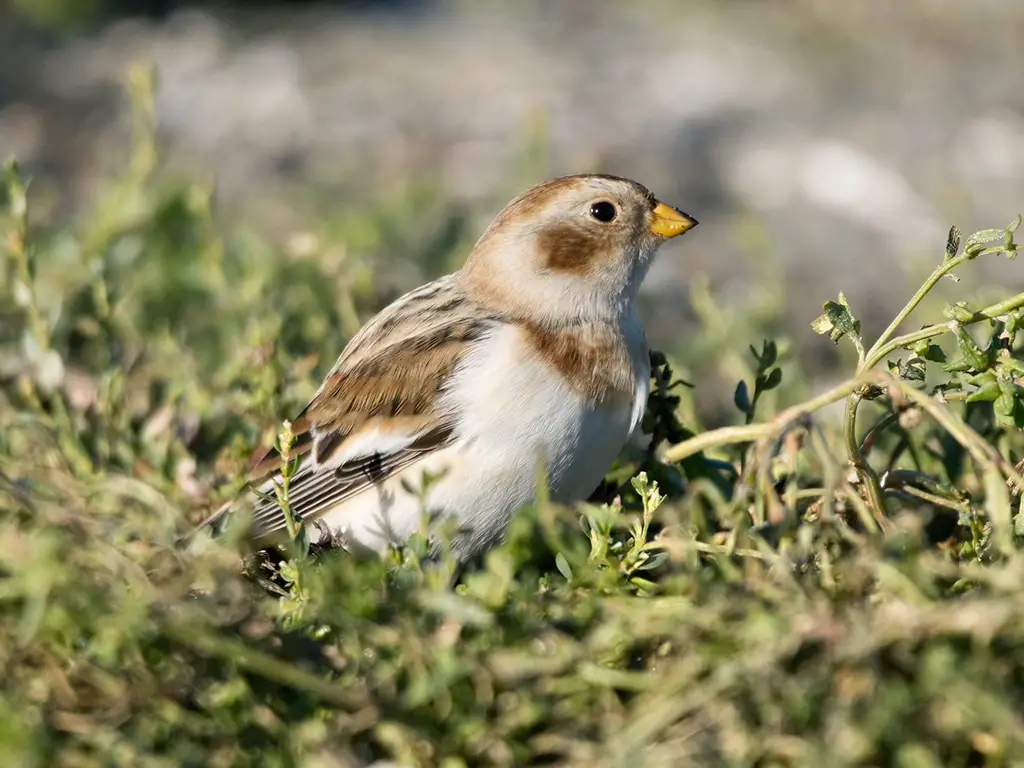
The Lapland Longspur is a small, robust songbird known for its striking breeding plumage and long hind claw. Males in summer have a black face and throat, white eye-ring, chestnut nape, and streaked back.
Females and non-breeding males are more subdued with streaked brown plumage. Native to the Arctic and subarctic regions, they migrate to open fields and grasslands in temperate zones during winter. These birds feed mainly on seeds and insects.
They are ground nesters and are known for their melodious songs, which males sing during flight displays. The Lapland Longspur is highly sociable in winter, often forming large mixed flocks with other seed-eating birds.
| Kingdom | Animalia |
| Phylum | Chordata |
| Clade | Dinosauria |
| Class | Aves |
| Order | Passeriformes |
| Family | Calcariidae |
| Genus | Calcarius |
| Species | C. lapponicus |
2. Gray-Crowned Rosy Finch (Leucosticte tephrocotis)
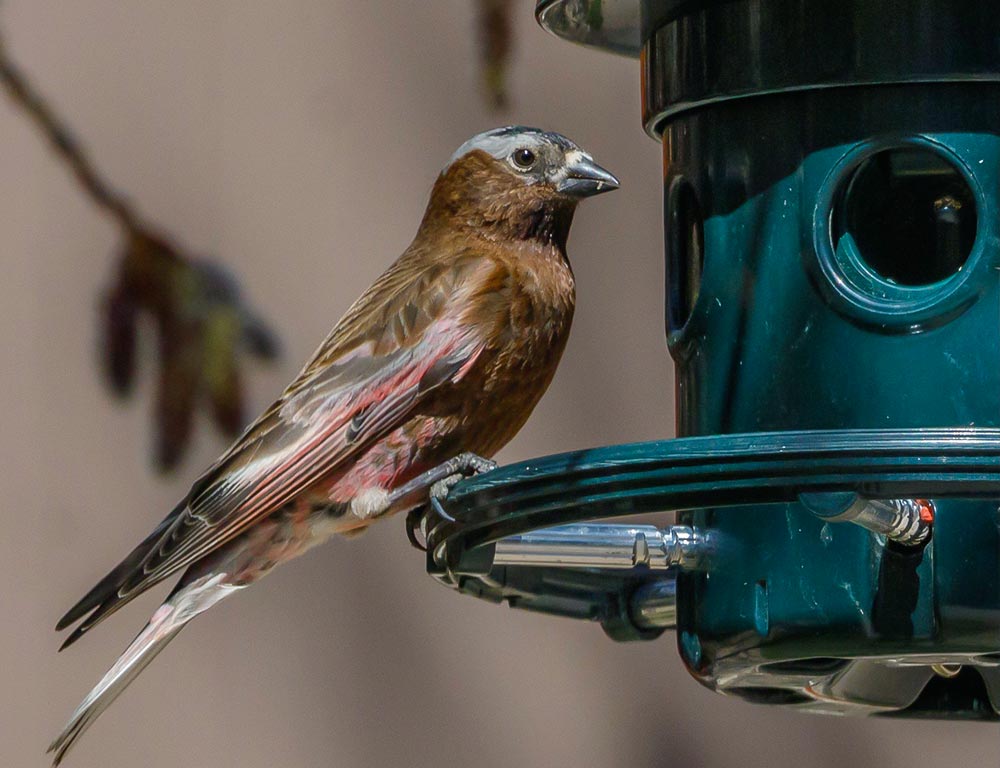
The Gray-Crowned Rosy Finch is a hardy bird, well-adapted to cold climates. It has a distinctive appearance with a gray head, black forehead, brownish body, and a rosy flush on the belly and wings.
This bird inhabits alpine and tundra regions of North America, often seen at high elevations. They descend to lower altitudes in winter. Their diet consists primarily of seeds and insects.
Gray-crowned rosy Finches are known for their undulating flight pattern. They often nest in rock crevices and are social birds, usually seen in flocks. Despite harsh living conditions, they are resilient and adept at foraging in snow.
| Kingdom | Animalia |
| Phylum | Chordata |
| Clade | Dinosauria |
| Class | Aves |
| Order | Passeriformes |
| Family | Fringillidae |
| Genus | Leucosticte |
| Species | L. tephrocotis |
3. Common Redpoll (Acanthis flammea)
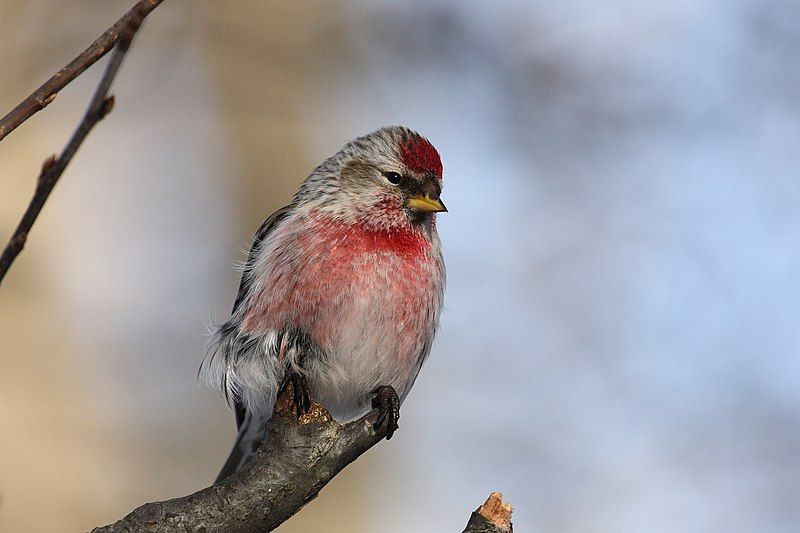
The Common Redpoll is a small finch with a distinctive red cap, black chin, and streaked brown body. Males have a pinkish wash on the chest.
They are native to the northern parts of North America and Eurasia, inhabiting birch forests and shrubby areas. In winter, they often migrate southward and visit bird feeders.
Redpolls feed on seeds, especially from birch and alder trees, and can store seeds in an expandable throat pouch. They are gregarious birds, usually seen in flocks. Redpolls are known for their resilience to cold temperatures and can burrow into the snow to stay warm.
| Kingdom | Animalia |
| Phylum | Chordata |
| Clade | Dinosauria |
| Class | Aves |
| Order | Passeriformes |
| Family | Fringillidae |
| Genus | Acanthis |
| Species | A. flammea |
4. House Sparrow (Passer domesticus)
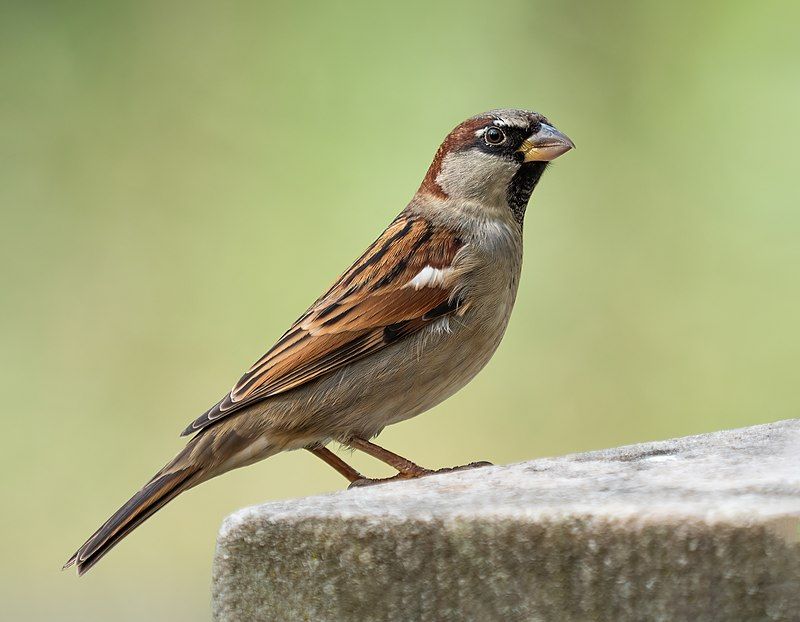
The House Sparrow, introduced from Europe, is now common in urban and suburban areas worldwide. Males have a distinctive gray crown, white cheeks, black bib, and rufous neck, while females are dull brown with grayish underparts.
They are adaptable, often found near human habitation. House Sparrows eat seeds, grains, and scraps, and can be aggressive towards other birds at feeders.
They nest in cavities and are known for their noisy, chattering song. Despite their name, they are not closely related to true sparrows in the family Emberizidae.
| Kingdom | Animalia |
| Phylum | Chordata |
| Clade | Dinosauria |
| Class | Aves |
| Order | Passeriformes |
| Family | Passeridae |
| Genus | Passer |
| Species | P. domesticus |
5. House Finch (Haemorhous mexicanus)
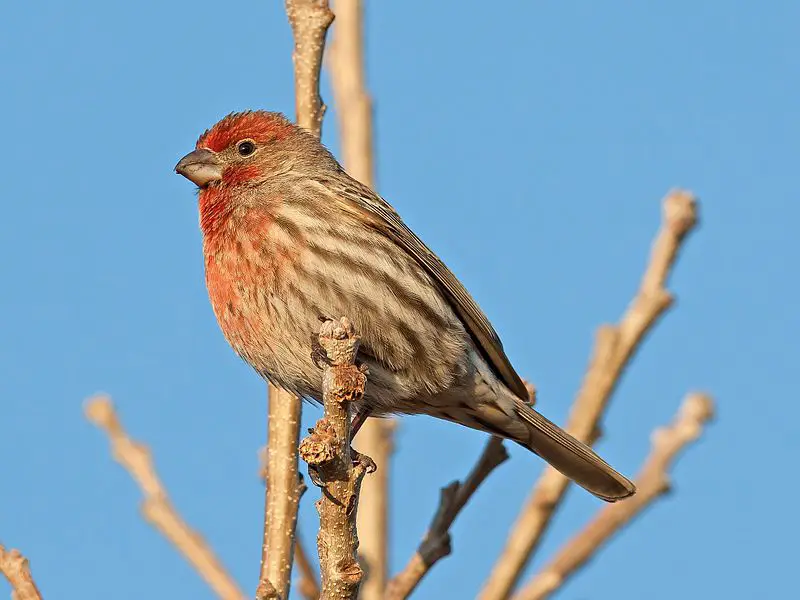
The House Finch is a small, sociable bird, primarily found in North America. Males are bright red around the face and upper breast, with streaked brown backs, tails, and bellies. Females are brown and heavily streaked.
Originally from the western U.S., they have been introduced to the eastern states. They adapt well to urban and suburban environments and are frequent visitors to bird feeders, where they primarily eat seeds and grains.
House Finches are known for their cheerful, warbling song and can be found in large, noisy groups.
| Kingdom | Animalia |
| Phylum | Chordata |
| Clade | Dinosauria |
| Class | Aves |
| Order | Passeriformes |
| Family | Fringillidae |
| Genus | Haemorhous |
| Species | H. mexicanus |
6. Downy Woodpecker (Picoides pubescens)
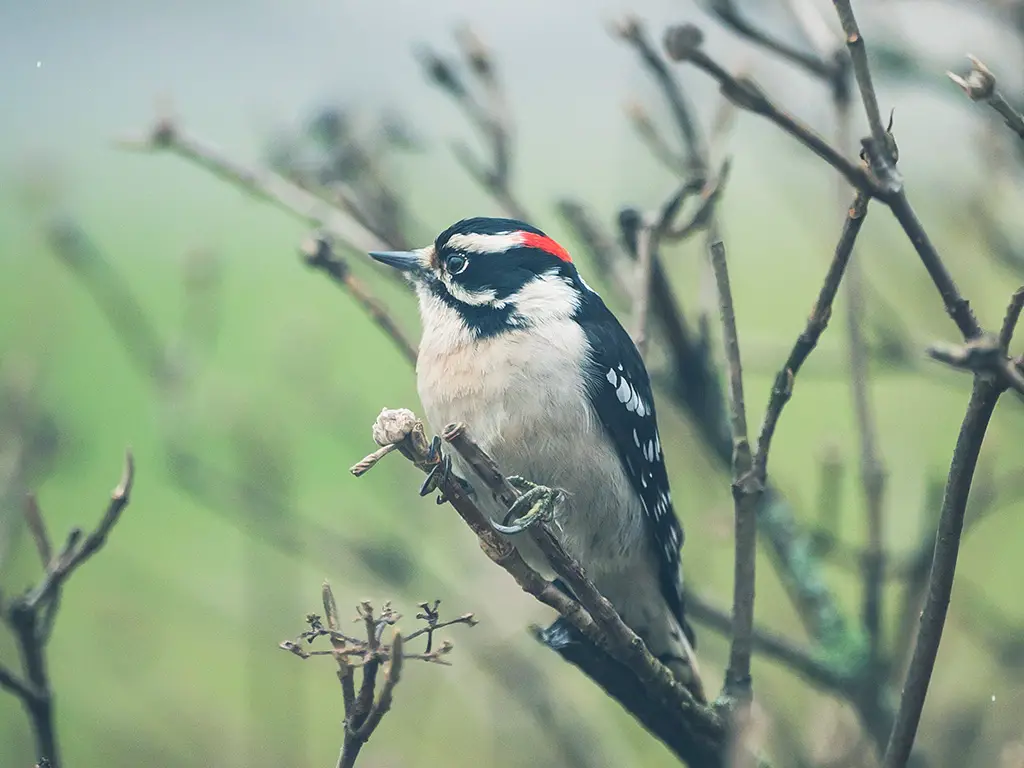
| Kingdom | Animalia |
| Phylum | Chordata |
| Clade | Dinosauria |
| Class | Aves |
| Order | Piciformes |
| Family | Picidae |
| Genus | Dryobates |
| Species | D. pubescens |
7. American Goldfinch (Spinus tristis)
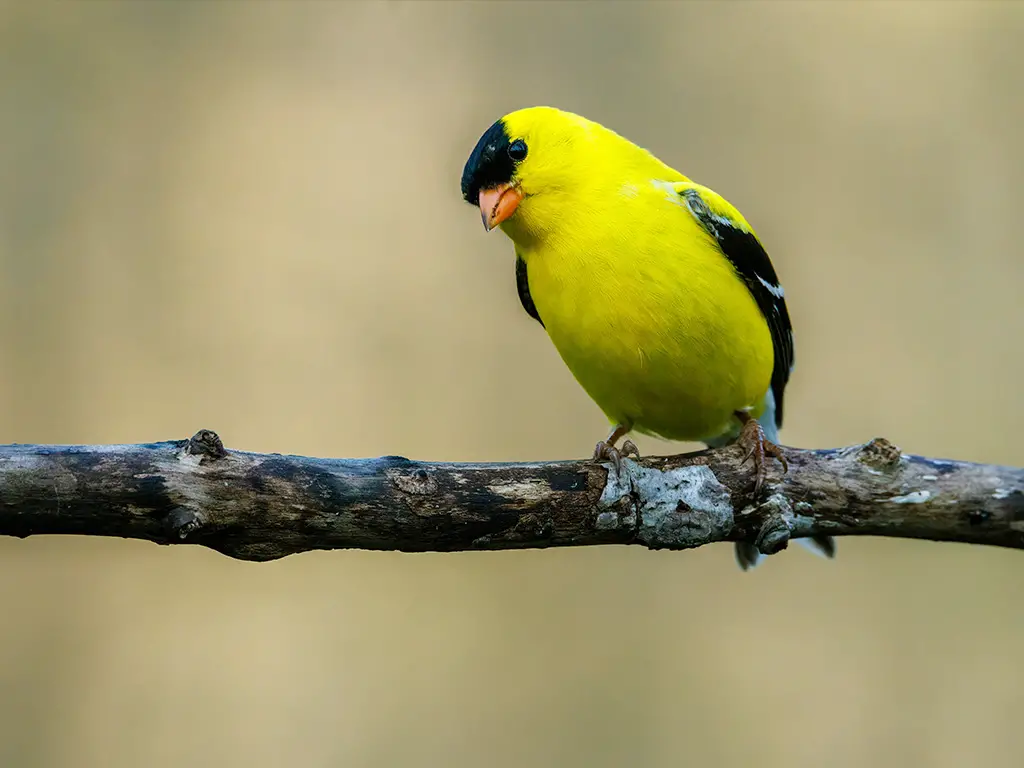
The American Goldfinch is a small, vibrant bird, known for its bright yellow plumage in males during the breeding season, accompanied by a black cap, wings, and tail.
Females and non-breeding males are more muted in color, primarily olive or brown. These birds are widespread across North America, inhabiting weedy fields, gardens, and open areas.
Goldfinches are predominantly seed eaters, with a particular fondness for thistle, and they are often seen at bird feeders. They are social birds, frequently observed in flocks.
Their flight is undulating and bouncy, accompanied by a distinctive, cheerful Twitter. Goldfinches nest later than many birds, waiting until mid-to-late summer when thistle seeds are abundant.
| Kingdom | Animalia |
| Phylum | Chordata |
| Clade | Dinosauria |
| Class | Aves |
| Order | Passeriformes |
| Family | Fringillidae |
| Genus | Spinus |
| Species | S. tristis |
8. American Robin (Turdus migratorius)
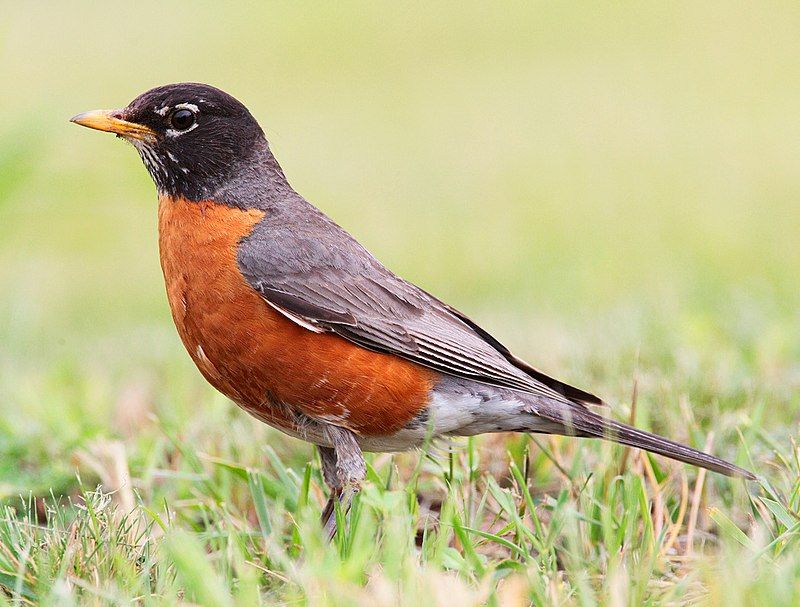
The American Robin is a familiar bird across North America, easily recognizable by its bright red or orange breast, gray back, and white throat with dark streaks.
Males and females have similar plumage, though females may be slightly paler. These birds are adaptable, thriving in diverse habitats including forests, parks, and suburban areas.
Robins are known for their rich, melodious song, often heard at dawn and dusk. They feed on earthworms, insects, and fruit.
The sight of robins pulling earthworms from the ground is a common springtime occurrence. They build nests in trees or shrubs and are often one of the first birds to breed in spring.
| Kingdom | Animalia |
| Phylum | Chordata |
| Clade | Dinosauria |
| Class | Aves |
| Order | Passeriformes |
| Family | Turdidae |
| Genus | Turdus |
| Species | T. migratorius |
9. Black-Capped Chickadee (Poecile atricapillus)
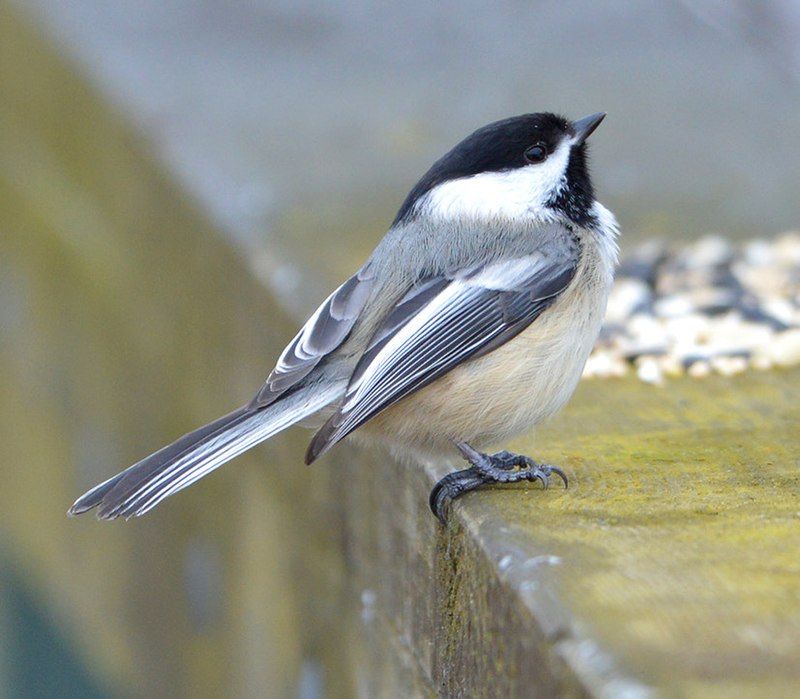
The Black-Capped Chickadee is a small, charismatic bird with a distinctive black cap and bib, white cheeks, and grayish body. Found across much of North America, particularly in wooded areas, they are known for their curiosity and boldness around humans.
Chickadees eat insects, seeds, and berries and are frequent visitors to bird feeders. They have a complex social structure and communicate with a variety of calls, including their familiar “chick-a-dee-dee-dee.” These birds are cavity nesters, often using old woodpecker holes.
The Black-Capped Chickadee’s ability to lower its body temperature during cold nights is a remarkable adaptation to its northern habitat.
| Kingdom | Animalia |
| Phylum | Chordata |
| Clade | Dinosauria |
| Class | Aves |
| Order | Passeriformes |
| Family | Paridae |
| Genus | Poecile |
| Species | P. atricapillus |
10. Cooper’s Hawk (Accipiter cooperii)
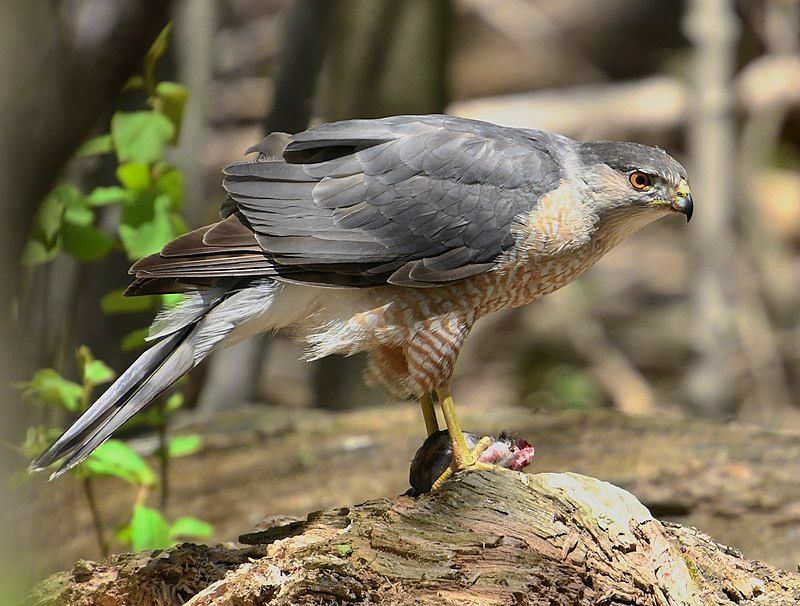
Cooper’s Hawk is a medium-sized hawk, adept at navigating through dense foliage in pursuit of prey. They have a blue-gray back, reddish-barred chest, and long, banded tail. Young birds are browner and streaked.
These hawks are found in forested habitats and urban areas across North America. Cooper’s Hawks primarily hunt birds and small mammals, exhibiting incredible agility in flight.
They have become more common in urban areas, often seen hunting near bird feeders. Their nests are usually built in tall trees. The resurgence of their population is a conservation success, having once been threatened by pesticide use.
| Kingdom | Animalia |
| Phylum | Chordata |
| Clade | Dinosauria |
| Class | Aves |
| Order | Accipitriformes |
| Family | Accipitridae |
| Genus | Accipiter |
| Species | A. cooperii |
11. Northern Flicker (Colaptes auratus)
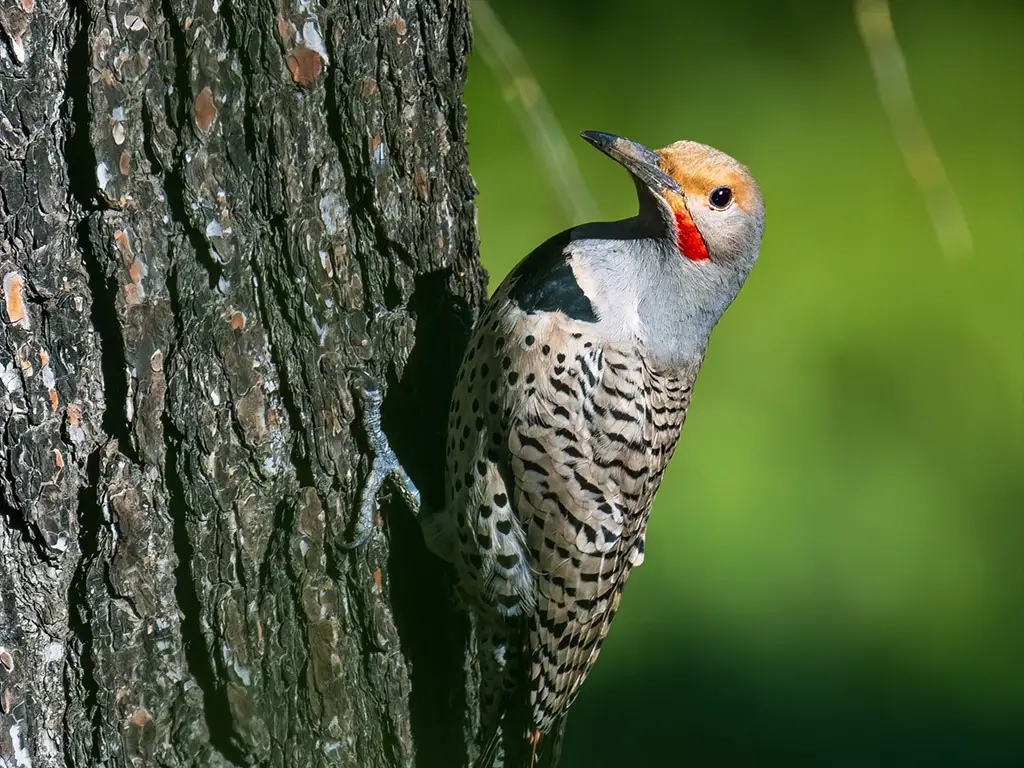
The Northern Flicker is a large, brown woodpecker with a distinctive black crescent on the chest, spotted belly, and a red or black “mustache” depending on the region.
There are two primary color forms: the yellow-shafted in the east and north, and the red-shafted in the west. Flickers are one of the few woodpecker species that frequently feed on the ground, primarily eating ants and beetles.
They can be found in a variety of habitats, including forests, edges, yards, and parks across North America.
Their loud call, which sounds like a loud “wick-wick-wick,” is often heard during their spring courtship. They nest in tree cavities and are known for their distinctive, undulating flight.
| Kingdom | Animalia |
| Phylum | Chordata |
| Clade | Dinosauria |
| Class | Aves |
| Order | Piciformes |
| Family | Picidae |
| Genus | Colaptes |
| Species | C. auratus |
12. Mourning Dove (Zenaida macroura)
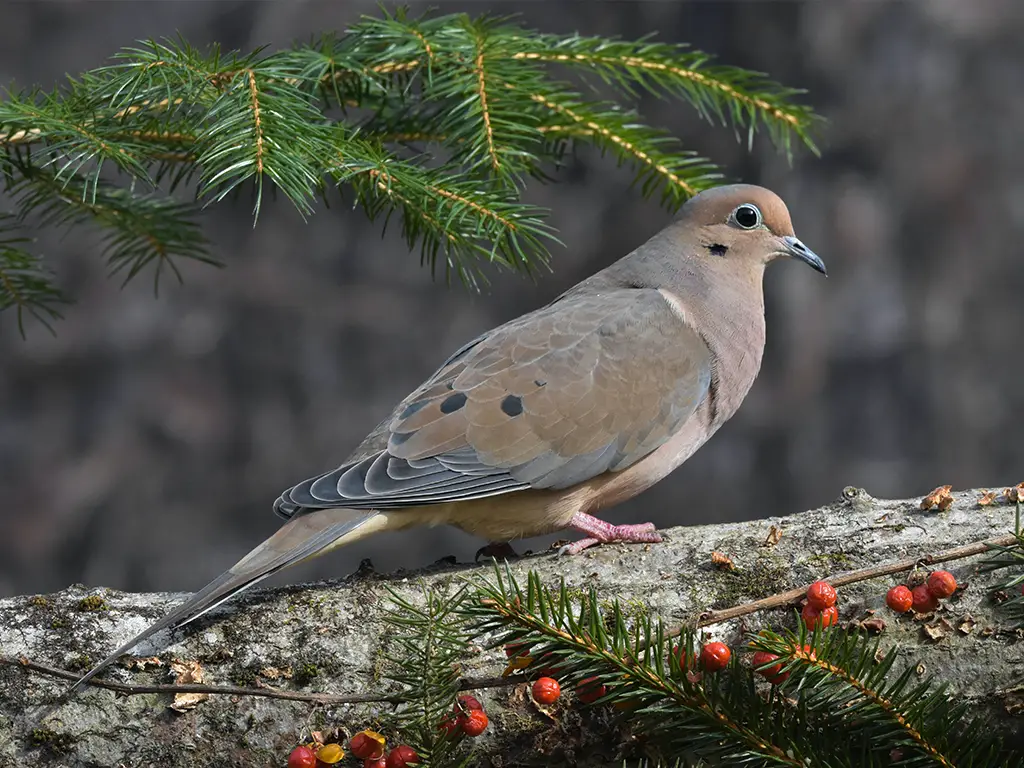
The Mourning Dove is a slender, graceful bird common across North America. It has a soft grayish-brown body, with a slightly iridescent neck, black spots on the wings, and a long, tapered tail edged with white.
Known for its mournful cooing, this dove is often associated with peace and tranquility. They are ground feeders, primarily eating seeds and occasionally berries and insects.
Mourning Doves are monogamous, often seen in pairs, and are known for their swift and straight flight. They prefer open or semi-open habitats and are frequent visitors to bird feeders.
Mourning Doves nest in trees and shrubs and are known for their flimsy, loosely constructed nests.
| Kingdom | Animalia |
| Phylum | Chordata |
| Clade | Dinosauria |
| Class | Aves |
| Order | Columbiformes |
| Family | Columbidae |
| Genus | Zenaida |
| Species | Z. macroura |
13. Red-Winged Blackbird (Agelaius phoeniceus)
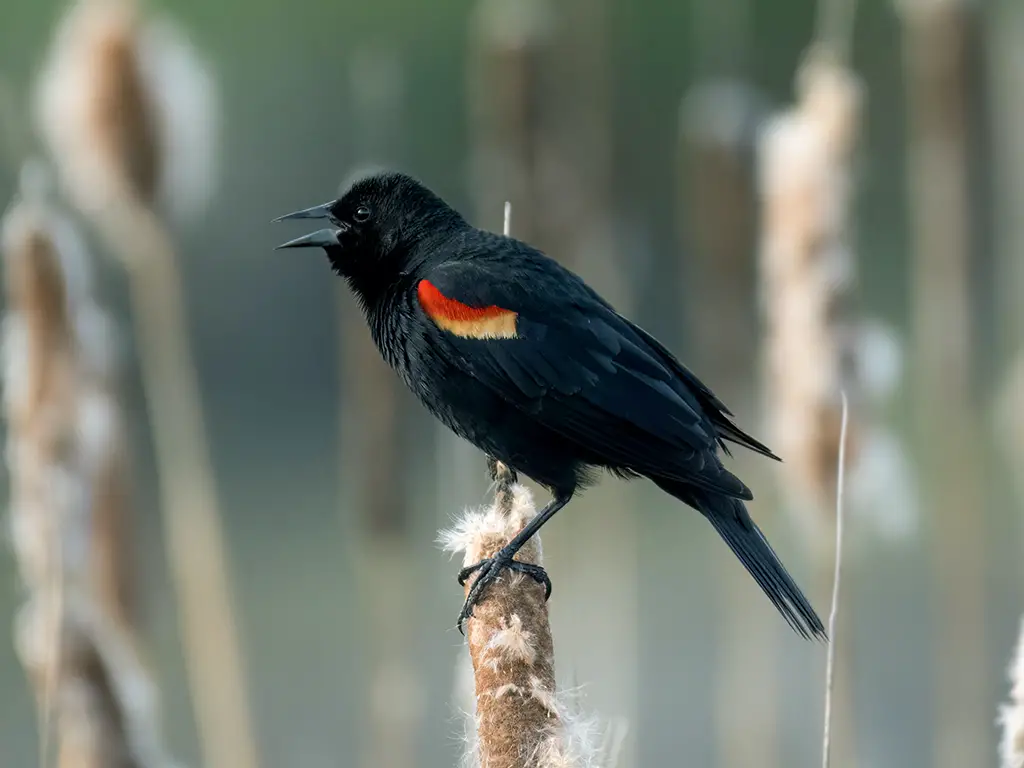
The Red-Winged Blackbird is a striking and widespread bird in North America. Males are black with bright red and yellow shoulder patches (epaulets), while females are brownish with streaks and more subdued in color.
These birds inhabit wetlands, marshes, and agricultural areas. They are social and often found in large flocks, especially during migration or in winter roosts.
Red-winged blackbirds are omnivorous, eating seeds, grains, insects, and small invertebrates.
They are known for their loud, gurgling songs and calls. Males are highly territorial during the breeding season, often seen perched conspicuously defending their territory.
| Kingdom | Animalia |
| Phylum | Chordata |
| Clade | Dinosauria |
| Class | Aves |
| Order | Passeriformes |
| Family | Icteridae |
| Genus | Agelaius |
| Species | A. phoeniceus |
14. Dark-Eyed Junco (Junco hyemalis)
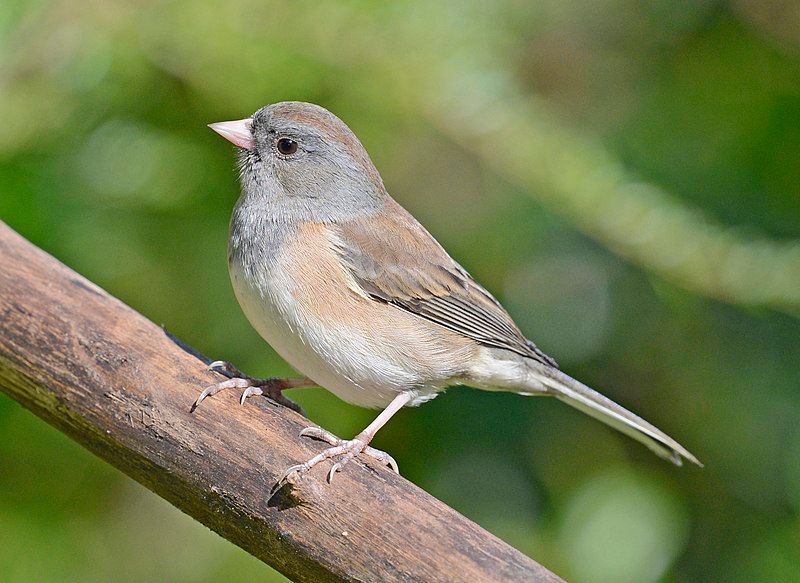
The Dark-Eyed Junco is a small, sparrow-sized bird with a rounded head and a short, stout bill. They have a dark gray or brown back and a white belly, with a distinctive white tail with dark outer feathers visible in flight.
Juncos are a common sight in forests, suburban areas, and at backyard feeders across North America, especially in winter. They primarily feed on seeds and insects.
These birds are known for their sweet, trilling songs and are often seen hopping on the ground or in low shrubs. Juncos vary in coloration across different regions but are all classified under the same species.
| Kingdom | Animalia |
| Phylum | Chordata |
| Clade | Dinosauria |
| Class | Aves |
| Order | Passeriformes |
| Family | Passerellidae |
| Genus | Junco |
| Species | J. hyemalis |
15. Black-Billed Magpie (Pica hudsonia)
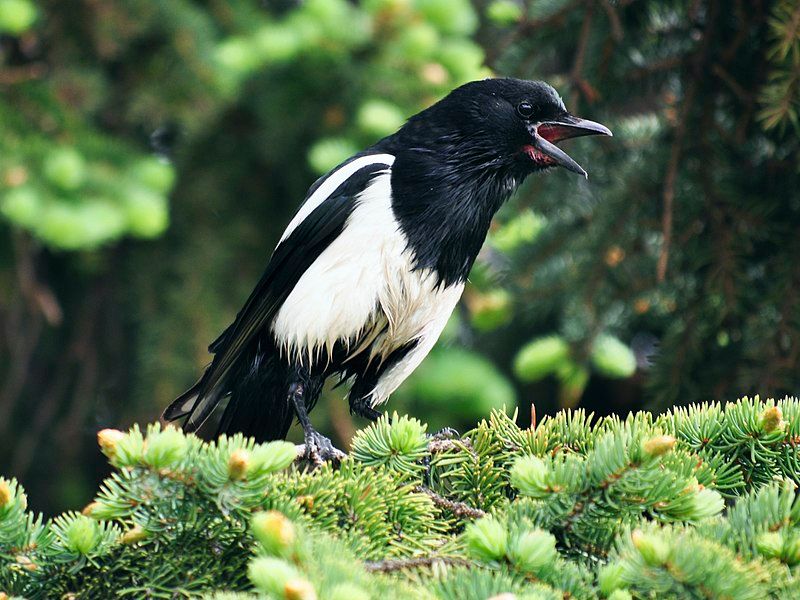
The Black-Billed Magpie is a large, striking bird with a long tail and iridescent black and white plumage. It has a black bill, head, and breast, and white shoulders and belly. Their wings and tail feathers exhibit a blue-green sheen in the light.
Native to western North America, they inhabit various habitats, from rural farmlands to urban areas. Magpies are intelligent and curious birds, known for their bold behavior.
They have a varied diet, including insects, small mammals, seeds, and carrion. Magpies are also known for their chattering calls and are often seen in pairs or small groups.
| Kingdom | Animalia |
| Phylum | Chordata |
| Clade | Dinosauria |
| Class | Aves |
| Order | Passeriformes |
| Family | Corvidae |
| Genus | Pica |
| Species | P. hudsonia |
16. Common Starling (Sturnus vulgaris)
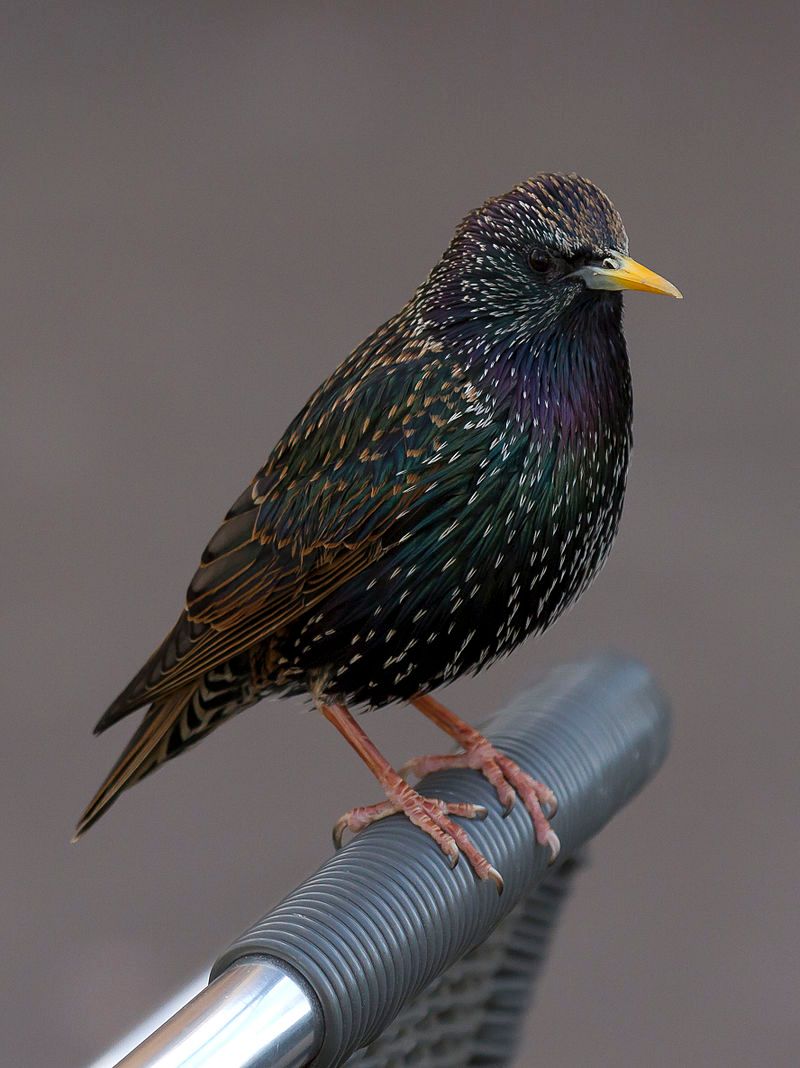
The Common Starling is a small to medium-sized passerine bird with iridescent black plumage that shows shades of green and purple in light. It has a short tail, pointed wings, and a long, slender beak.
Native to Europe, Asia, and North Africa, it has been introduced to other regions, including North America and Australasia. Starlings are highly social and often seen in large flocks.
They are omnivorous, eating a variety of insects, fruits, and seeds. Starlings are known for their vocal abilities, mimicking various sounds, including human speech. They nest in cavities and are known to adapt well to urban environments.
| Kingdom | Animalia |
| Phylum | Chordata |
| Clade | Dinosauria |
| Class | Aves |
| Order | Passeriformes |
| Family | Sturnidae |
| Genus | Sturnus |
| Species | S. vulgaris |
17. Song Sparrow (Melospiza melodia)
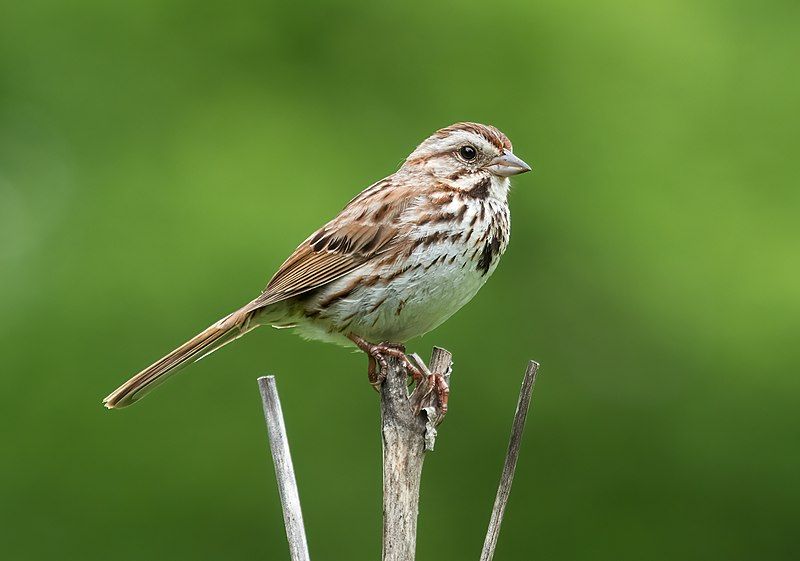
| Kingdom | Animalia |
| Phylum | Chordata |
| Clade | Dinosauria |
| Class | Aves |
| Order | Passeriformes |
| Family | Passerellidae |
| Genus | Melospiza |
| Species | M. melodia |
18. Eurasian Collared Dove (Streptopelia decaocto)
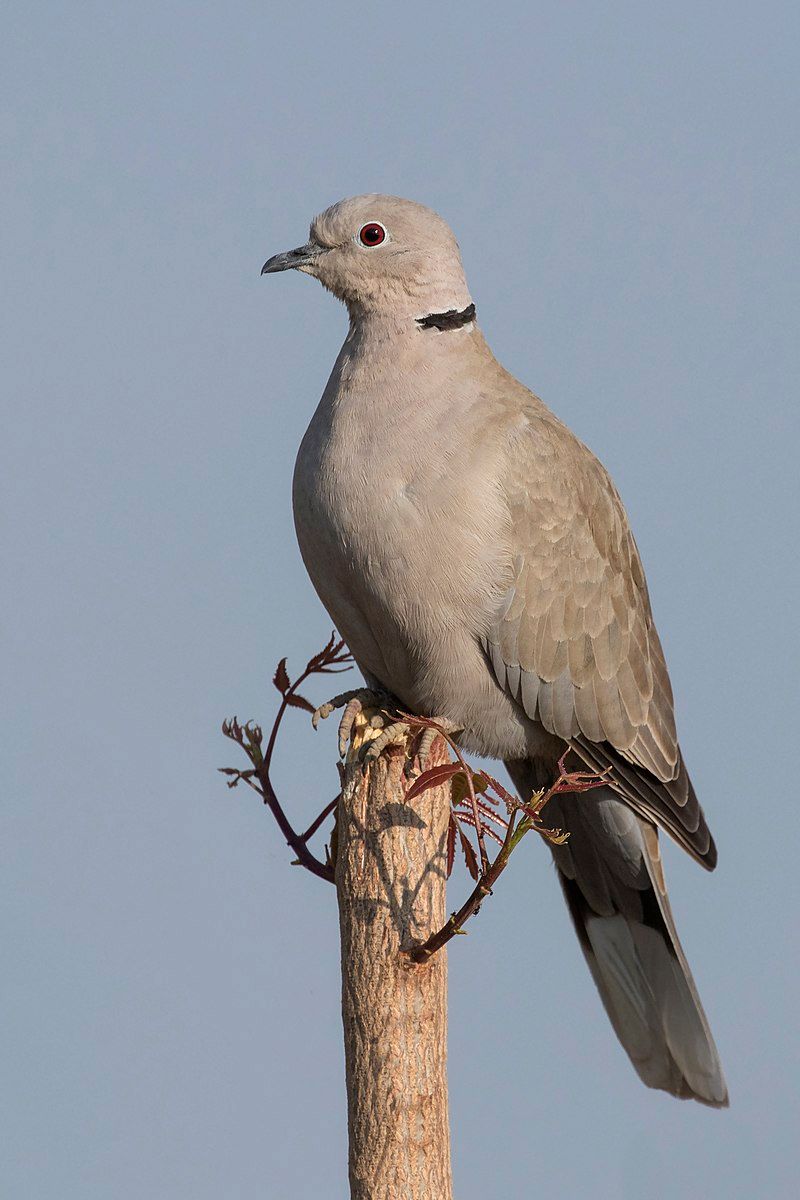
The Eurasian Collared Dove is a medium-sized dove with a uniform grayish-brown plumage and a distinctive black collar around the nape. It has a long tail, red eyes, and a light pinkish breast.
Originally native to Asia and Europe, this species has expanded its range dramatically, including into North America. They adapt well to human habitation and are often seen in urban areas, gardens, and farmlands.
These doves feed mainly on seeds and grains and are often found in pairs or small flocks. They have a soft, repetitive cooing call. The Eurasian Collared Dove is known for its rapid breeding and has become common in many of its new territories.
| Kingdom | Animalia |
| Phylum | Chordata |
| Clade | Dinosauria |
| Class | Aves |
| Order | Columbiformes |
| Family | Columbidae |
| Genus | Streptopelia |
| Species | S. decaocto |
19. Yellow-Rumped Warbler (Setophaga coronata)
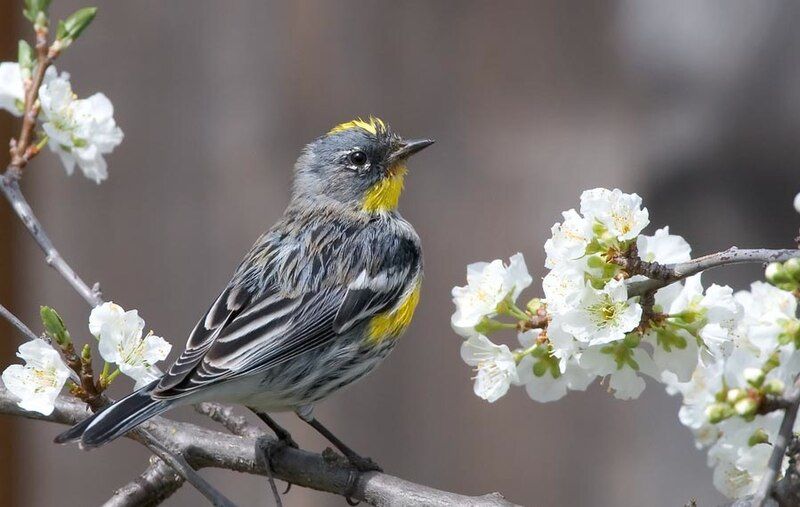
The Yellow-Rumped Warbler is a small, colorful bird, easily recognized by its bright yellow rump. It has a streaked back, white throat, and black mask. There are two main color variants: the grayish “Myrtle” in the East and the brownish “Audubon’s” in the West.
These warblers are versatile and can be found in a variety of habitats, including coniferous and mixed forests.
They migrate long distances between their breeding grounds in Canada and the northern U.S. and wintering areas in the southern U.S. and Central America.
They feed on insects and berries, notably being one of the few warblers that can digest the waxes in bayberries and wax myrtles.
| Kingdom | Animalia |
| Phylum | Chordata |
| Clade | Dinosauria |
| Class | Aves |
| Order | Passeriformes |
| Family | Parulidae |
| Genus | Setophaga |
| Species | S. coronata |
20. Red-Tailed Hawk (Buteo jamaicensis)
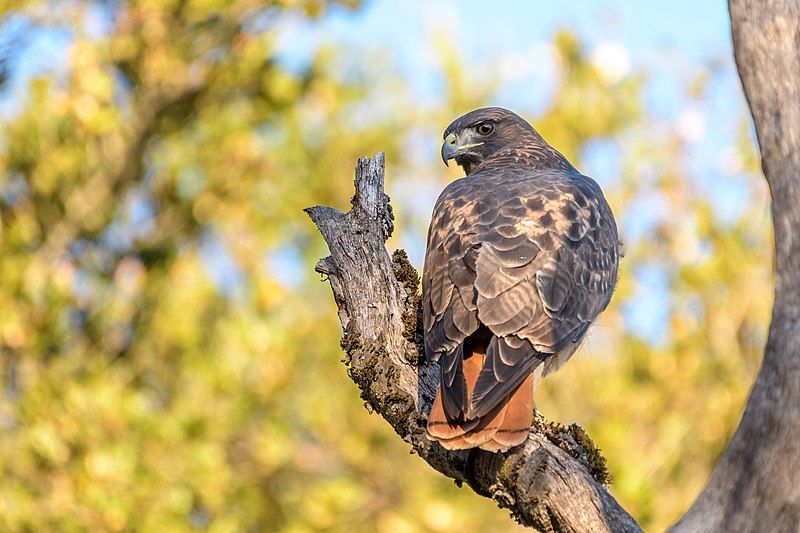
The Red-Tailed Hawk is a large, powerful raptor known for its broad, rounded wings and a short, wide tail with a distinctive reddish hue. It has a varied plumage but generally exhibits a brown back and a pale underside with a dark belly band.
This hawk is widespread in North America and adapts to a wide range of habitats, including forests, fields, deserts, and urban areas.
They are often seen soaring in the sky or perched atop trees and poles. Red-tailed hawks feed on small mammals, birds, and reptiles.
They are known for their piercing screech, often used in movies as a generic bird of prey call.
| Kingdom | Animalia |
| Phylum | Chordata |
| Clade | Dinosauria |
| Class | Aves |
| Order | Accipitriformes |
| Family | Accipitridae |
| Genus | Buteo |
| Species | B. jamaicensis |
21. American Kestrel (Falco sparverius)
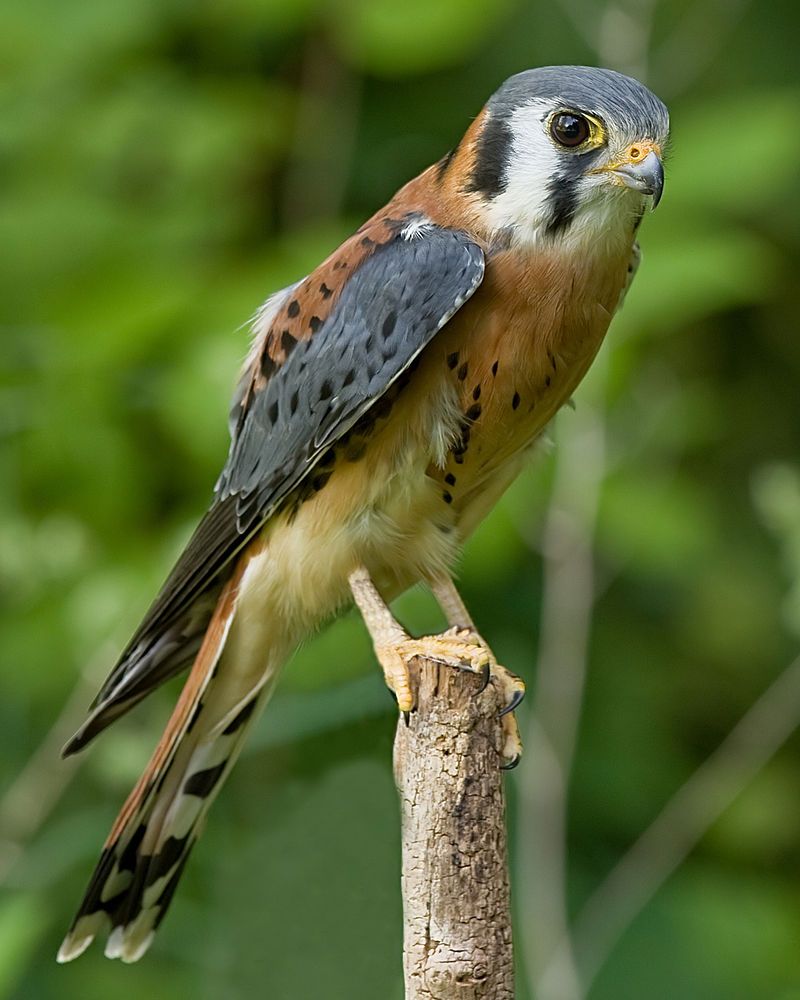
The American Kestrel, North America’s smallest falcon, is known for its strikingly colorful plumage. Males have slate-blue wings and a rusty back and tail, while females have brown, barred plumage.
Both sexes exhibit a distinctive facial pattern with two black slashes on the face. Kestrels are found in a variety of open habitats, including fields, parks, and suburban areas.
They feed on insects, small mammals, and birds, often seen hovering in the air before diving to catch prey. American Kestrels are cavity nesters and use old woodpecker holes or nest boxes. Their presence in an area is a good indicator of a healthy ecosystem.
| Kingdom | Animalia |
| Phylum | Chordata |
| Clade | Dinosauria |
| Class | Aves |
| Order | Falconiformes |
| Family | Falconidae |
| Genus | Falco |
| Species | F. sparverius |
22. Snow Bunting (Plectrophenax nivalis)
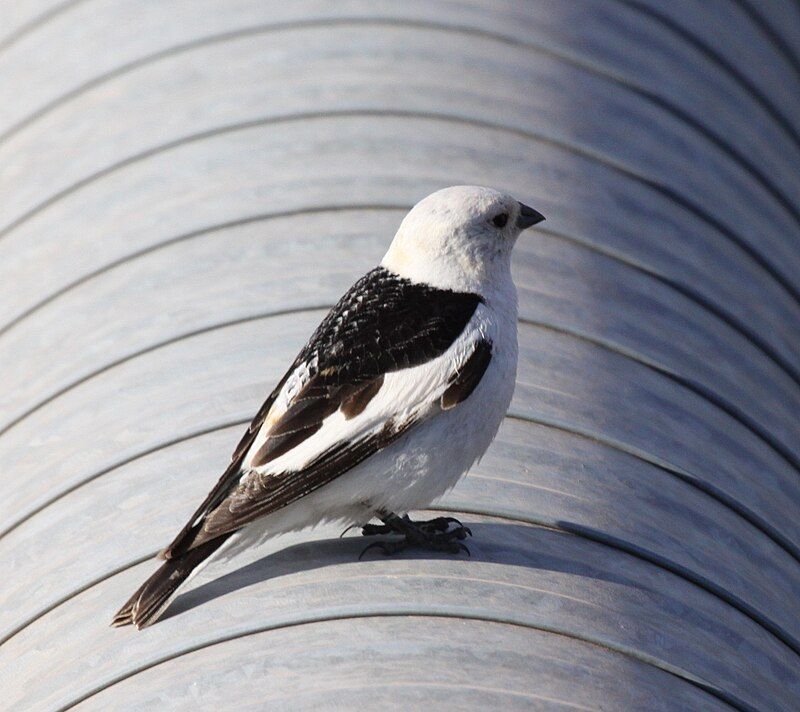
The Snow Bunting is a small, hardy bird with striking white and black breeding plumage, resembling a snowflake. In winter, they have more brown and black in their plumage.
Native to the Arctic regions, they migrate to fields and open landscapes in northern parts of North America and Eurasia during winter. Snow Buntings feed primarily on seeds but also consume insects during the breeding season.
They are ground nesters, often nesting in rock crevices. Known for their resilience to cold temperatures, Snow Buntings are a symbol of the harsh beauty of Arctic and subarctic environments.
| Kingdom | Animalia |
| Phylum | Chordata |
| Clade | Dinosauria |
| Class | Aves |
| Order | Passeriformes |
| Family | Calcariidae |
| Genus | Plectrophenax |
| Species | P. nivalis |
23. Harris’s Sparrow (Zonotrichia querula)
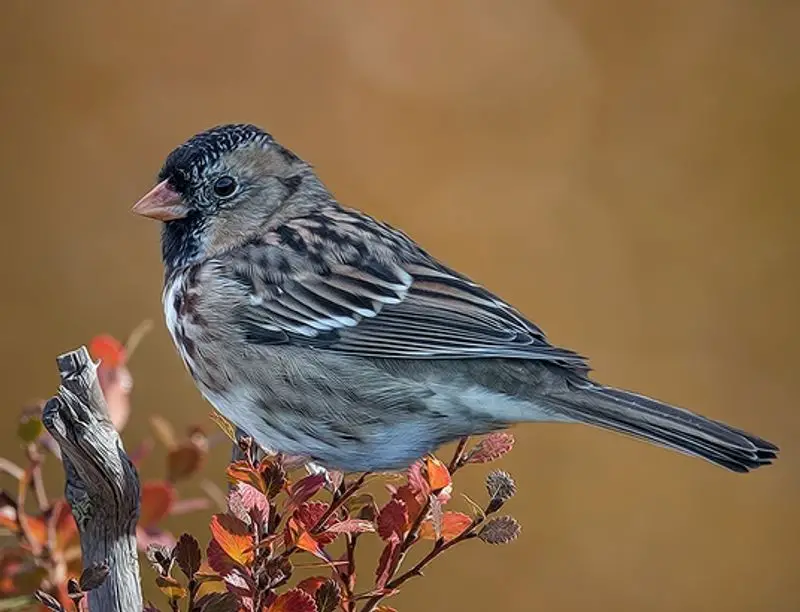
| Kingdom | Animalia |
| Phylum | Chordata |
| Clade | Dinosauria |
| Class | Aves |
| Order | Passeriformes |
| Family | Passerellidae |
| Genus | Zonotrichia |
| Species | Z. querula |
24. Rough-Legged Buzzard (Buteo lagopus)
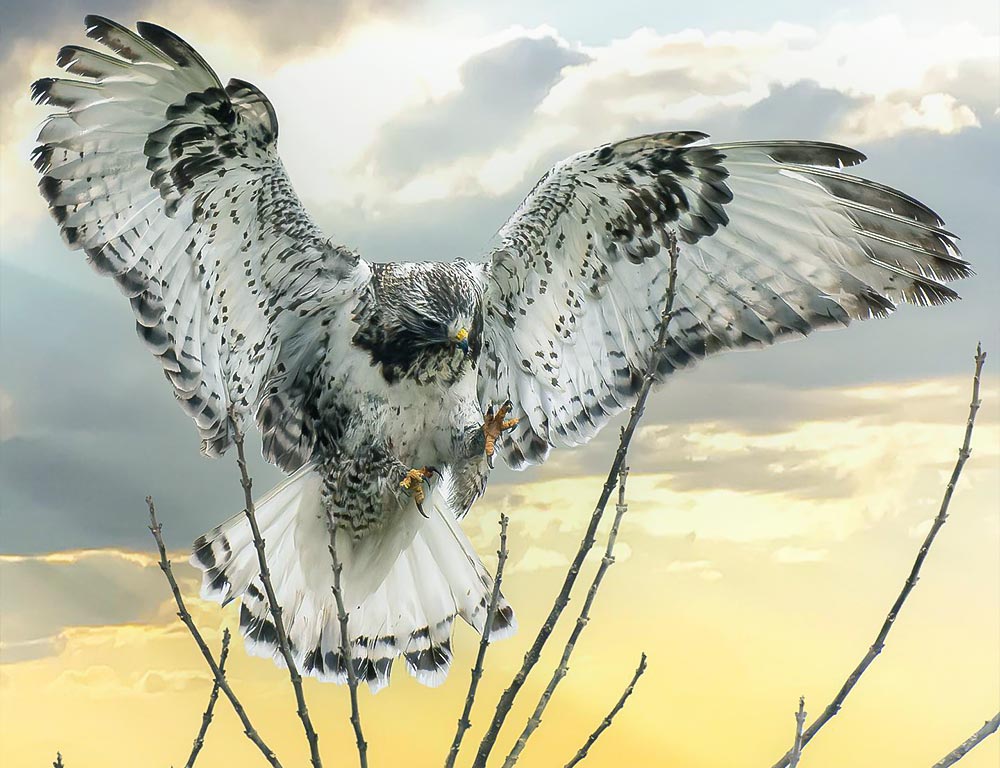
The Rough-Legged Buzzard, also known as the Rough-Legged Hawk in North America, is a large raptor with long wings and a broad tail. It gets its name from the feathered legs that reach down to the toes, an adaptation to its Arctic and subarctic habitats.
The plumage varies from light to dark morphs, but generally, it has a pale head and underparts with dark patches at the carpal joints and a dark belly band.
This bird breeds in the Arctic tundra and migrates south to open fields and marshes in winter. It feeds primarily on small mammals, often hunting by hovering in the air.
The Rough-Legged Buzzard is known for its ability to withstand extremely cold temperatures during the harsh Arctic winters.
| Kingdom | Animalia |
| Phylum | Chordata |
| Clade | Dinosauria |
| Class | Aves |
| Order | Accipitriformes |
| Family | Accipitridae |
| Genus | Buteo |
| Species | B. lagopus |
25. Red-Breasted Nuthatch (Sitta canadensis)
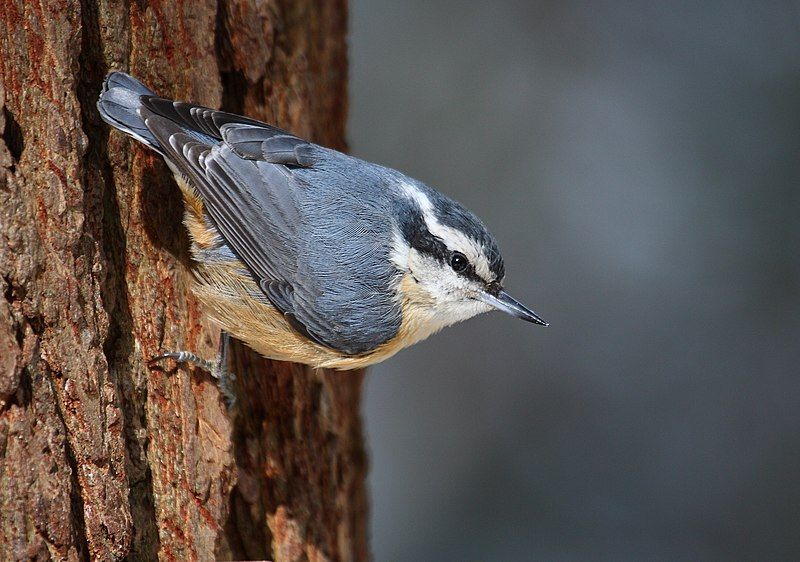
The Red-Breasted Nuthatch is a small, active bird with a blue-gray back and a distinctive black cap. It has a rusty-red breast, a white throat, and a black eye stripe.
Known for its ability to climb down trees headfirst, it inhabits coniferous forests in North America. This bird feeds on insects and seeds, often caching seeds under tree bark. Its call is a sharp, tinny “ank-ank-ank.”
Red-breasted nuthatches are cavity nesters, often using resin to reduce the size of the nest entrance. They are solitary or in pairs, and less social compared to other nuthatches. Their unique behavior and vocalizations make them a delightful presence in their habitats.
| Kingdom | Animalia |
| Phylum | Chordata |
| Clade | Dinosauria |
| Class | Aves |
| Order | Passeriformes |
| Family | Sittidae |
| Genus | Sitta |
| Species | S. canadensis |
26. Pine Siskin (Spinus pinus)
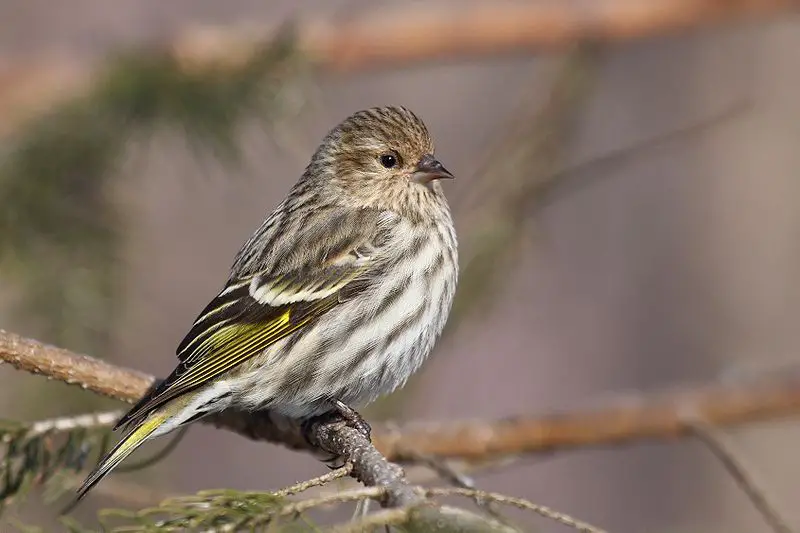
The Pine Siskin is a small, finch-like bird with streaky brown plumage and hints of yellow in the wings and tail. It’s known for its erratic migration patterns, sometimes appearing in large numbers outside its usual range.
Native to North America, Pine Siskins are found in coniferous and mixed forests, often visiting bird feeders in flocks.
They primarily eat seeds, especially from conifers, alders, and birches. Their song is a mix of twitters and trills, and they have a distinctive “zzzrr” flight call. Pine Siskins are social birds, often mingling with other finch species.
| Kingdom | Animalia |
| Phylum | Chordata |
| Clade | Dinosauria |
| Class | Aves |
| Order | Passeriformes |
| Family | Fringillidae |
| Genus | Spinus |
| Species | S. pinus |
27. Mallard (Anas platyrhynchos)
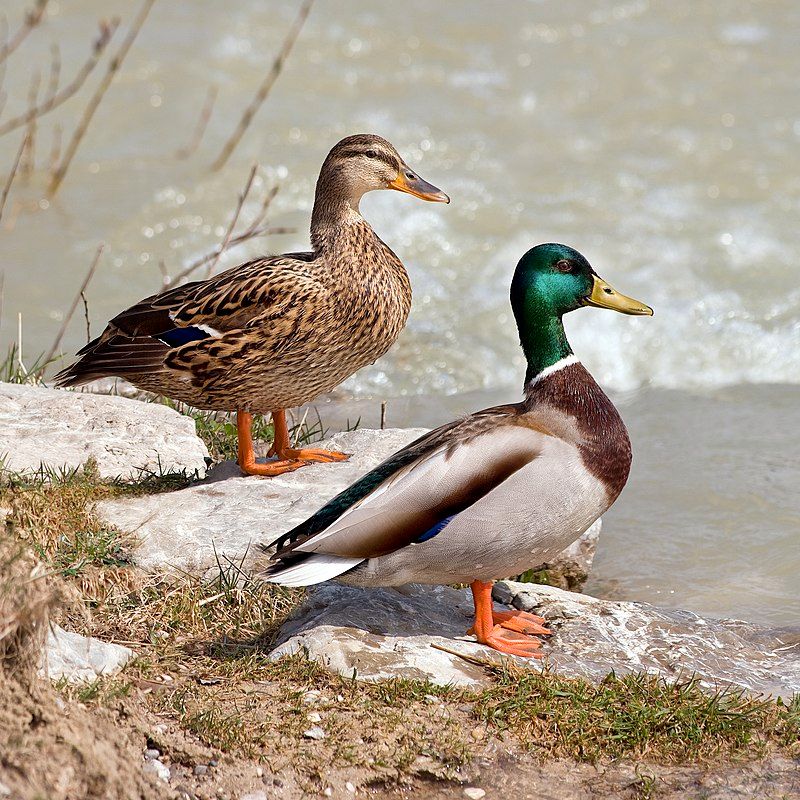
The Mallard is a familiar, dabbling duck with a distinctive appearance. Males have a glossy green head, white neck ring, chestnut breast, and gray body, while females are mottled brown for camouflage.
They are found in a variety of freshwater habitats worldwide, including parks and urban ponds. Mallards are omnivorous, feeding on aquatic vegetation, invertebrates, and grains. They are highly adaptable, often interacting with humans.
Mallards are the ancestors of most domestic duck breeds and play a crucial role in the ecosystem as a food source for predators and as seed dispersers.
| Kingdom | Animalia |
| Phylum | Chordata |
| Clade | Dinosauria |
| Class | Aves |
| Order | Anseriformes |
| Family | Anatidae |
| Genus | Anas |
| Species | A. platyrhynchos |
28. Sharp-Shinned Hawk (Accipiter striatus)
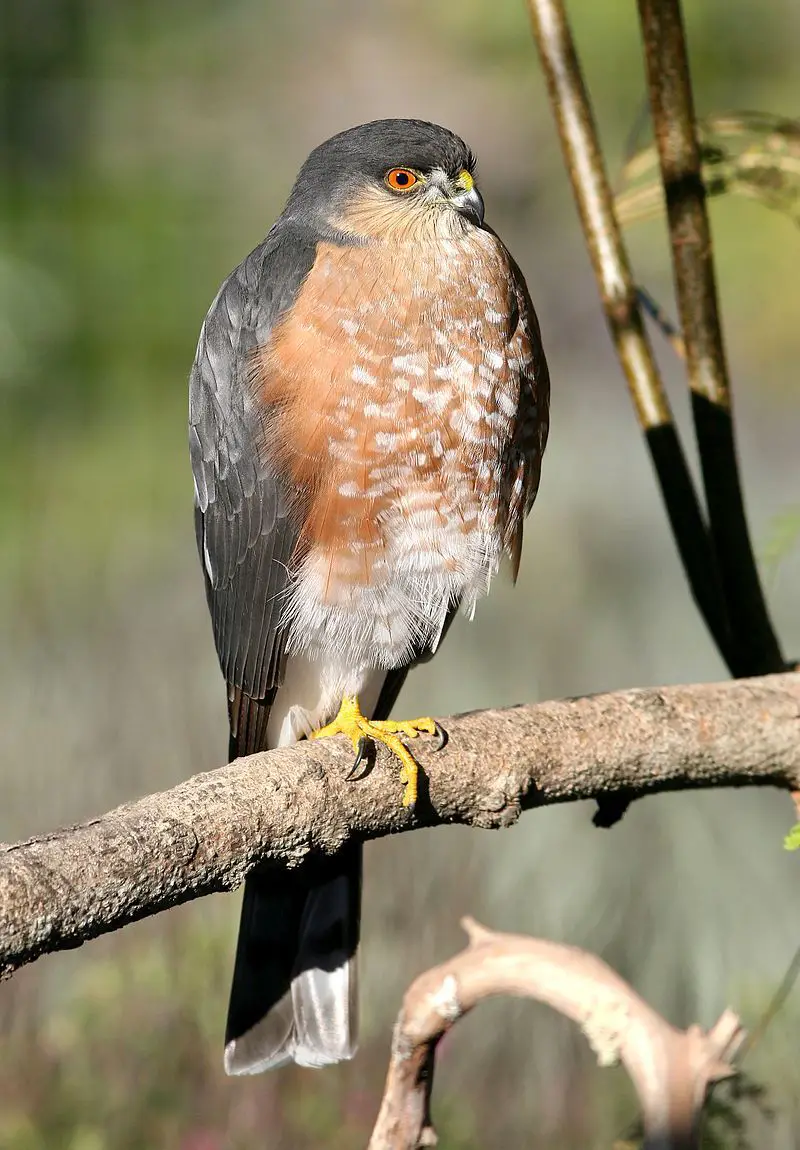
The Sharp-Shinned Hawk is the smallest in North America. It has a slate-gray back, barred underparts, and a narrow, squared-off tail. Known for its agility, it hunts birds in dense woods, often near bird feeders.
These hawks are migratory, breeding in forests and wintering in open woodlands or suburban areas.
They have a sharp, high-pitched call and are known for their fast, acrobatic flight. Sharp-shinned hawks are solitary except during migration, and they are fiercely territorial during the breeding season.
| Kingdom | Animalia |
| Phylum | Chordata |
| Clade | Dinosauria |
| Class | Aves |
| Order | Accipitriformes |
| Family | Accipitridae |
| Genus | Accipiter |
| Species | A. striatus |
29. American Wigeon (Mareca americana)
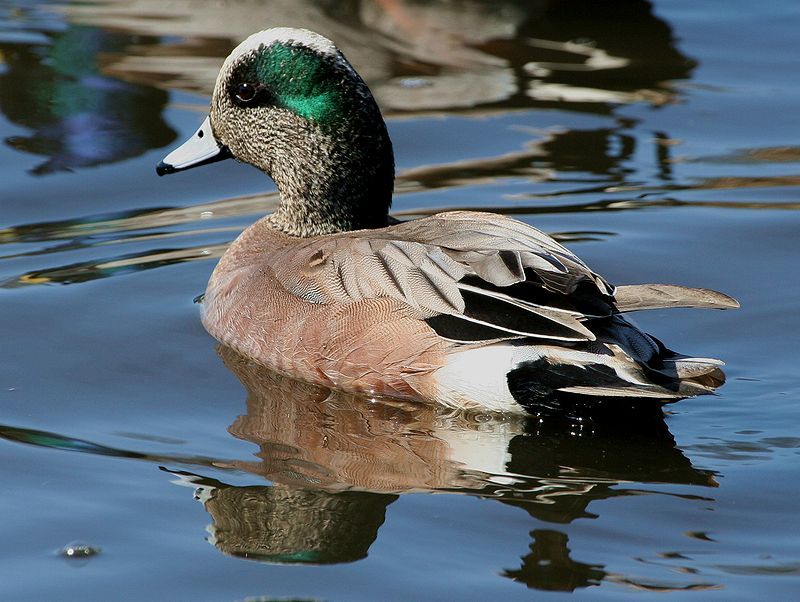
The American Wigeon is a medium-sized, attractive duck with a unique whistle-like call. Males have a green eye patch, white forehead, and a buff breast, while females are mottled brown.
They are found in ponds, marshes, and coastal habitats in North America. American Wigeons are dabbling ducks, feeding on aquatic plants, and they often graze on grasses and crops.
They are known for their sociable nature, often flocking with other duck species. During breeding, they nest near water in grassy areas.
| Kingdom | Animalia |
| Phylum | Chordata |
| Clade | Dinosauria |
| Class | Aves |
| Order | Anseriformes |
| Family | Anatidae |
| Genus | Mareca |
| Species | M. americana |
30. Gadwall (Mareca strepera)
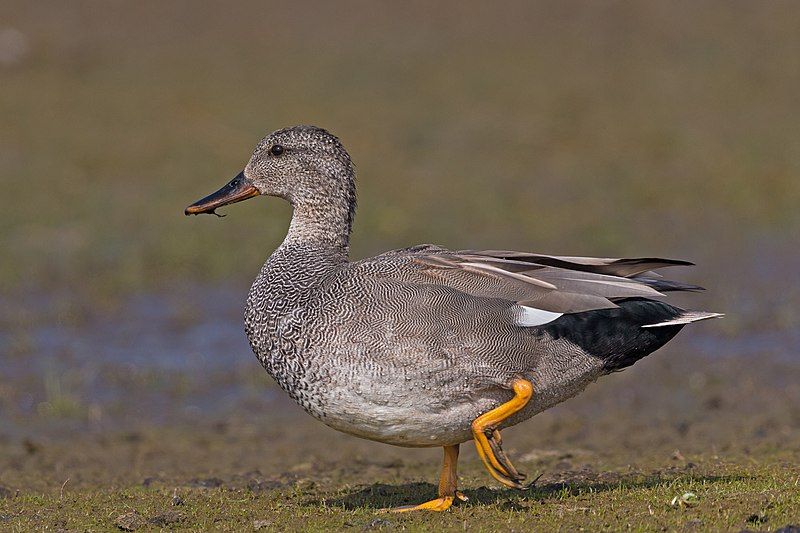
| Kingdom | Animalia |
| Phylum | Chordata |
| Clade | Dinosauria |
| Class | Aves |
| Order | Anseriformes |
| Family | Anatidae |
| Genus | Mareca |
| Species | M. strepera |
31. Pileated Woodpecker (Dryocopus pileatus)
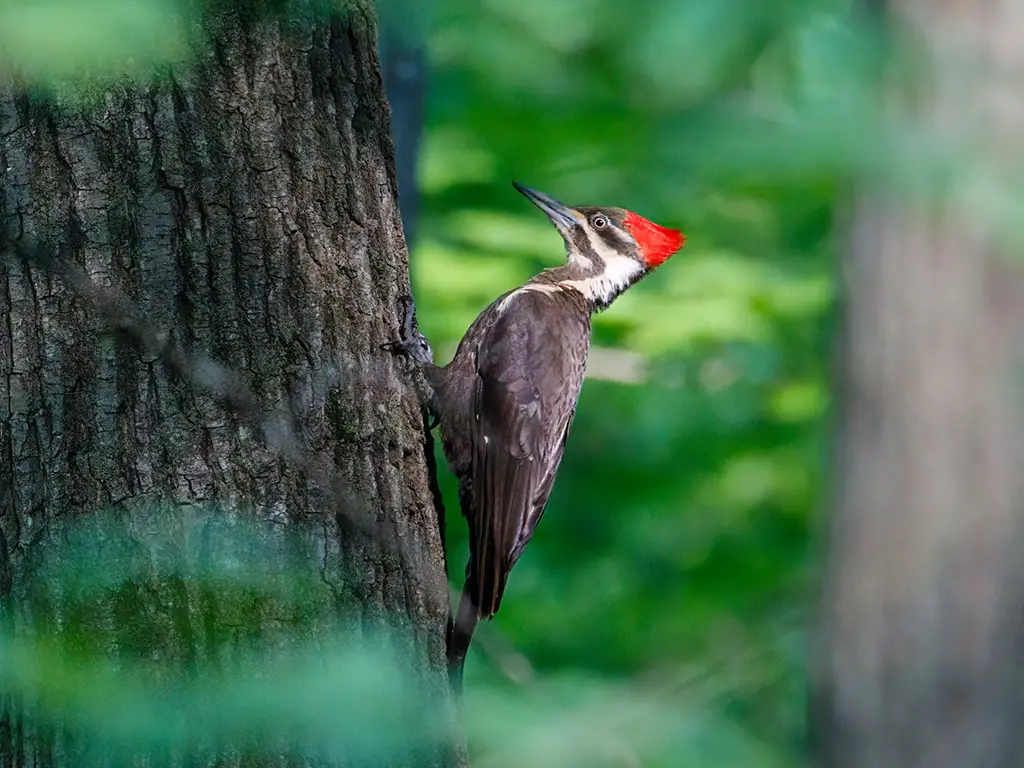
The Pileated Woodpecker is one of the largest woodpeckers in North America, easily recognized by its size, striking black and white plumage, and prominent red crest. It has a black body with white stripes on the face and neck and a white wing lining.
These birds inhabit mature forests, especially those with large, dead trees they use for nesting and feeding. Pileated Woodpeckers primarily eat insects, especially carpenter ants, which they excavate from dead wood with their powerful bills.
Their drumming and loud, distinctive calls are characteristic sounds of their habitat. Their excavation work helps other species by creating nesting sites and releasing insect populations for other wildlife.
| Kingdom | Animalia |
| Phylum | Chordata |
| Clade | Dinosauria |
| Class | Aves |
| Order | Piciformes |
| Family | Picidae |
| Genus | Dryocopus |
| Species | D. pileatus |
32. Cedar Waxwing (Bombycilla cedrorum)
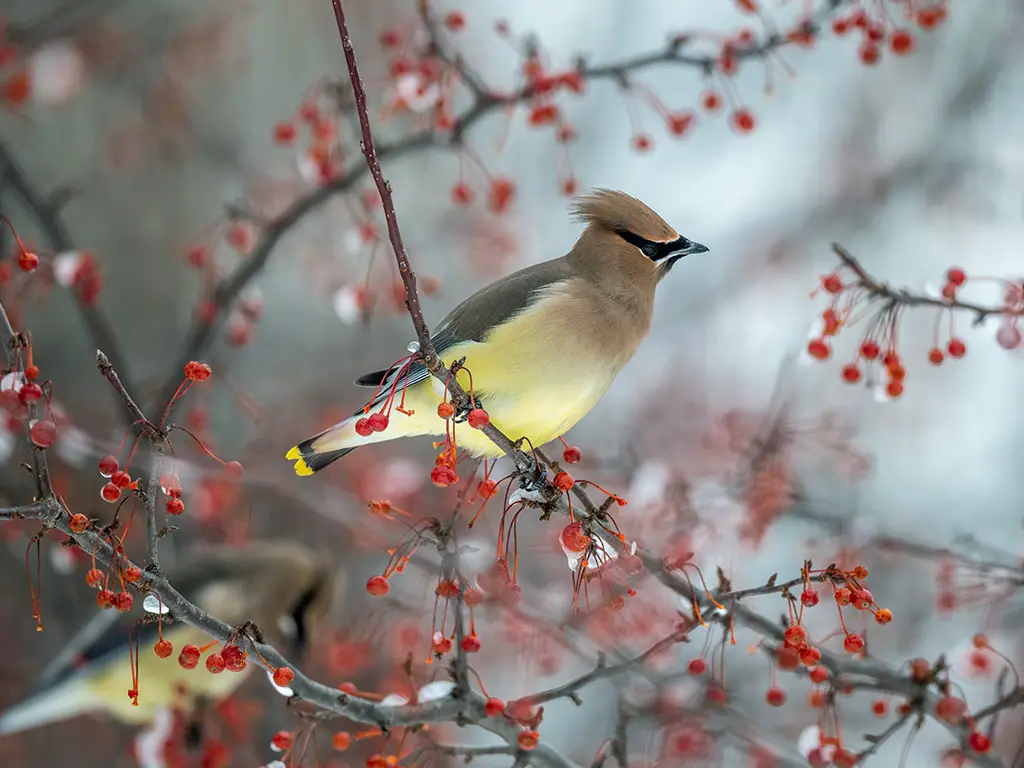
The Cedar Waxwing is a sleek, medium-sized bird with a crest, black mask, and brown, gray, and yellow plumage. A notable feature is the waxy red tips on the wing feathers. These birds are found in North America in forests, orchards, and gardens, often near water.
They primarily feed on fruit, supplemented by insects, and are known for their habit of passing fruit to each other in a line. Cedar Waxwings are social birds, usually seen in flocks.
They have a high, thin call and are known for their elegant appearance and behavior. They nest in trees, often near water, and can have two broods in a single season.
| Kingdom | Animalia |
| Phylum | Chordata |
| Clade | Dinosauria |
| Class | Aves |
| Order | Passeriformes |
| Family | Bombycillidae |
| Genus | Bombycilla |
| Species | B. cedrorum |
33. White-Crowned Sparrow (Zonotrichia leucophrys)
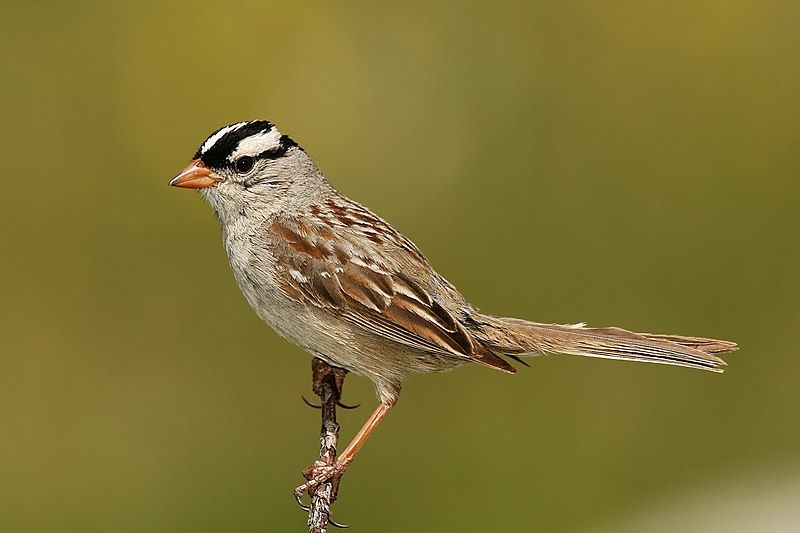
| Kingdom | Animalia |
| Phylum | Chordata |
| Clade | Dinosauria |
| Class | Aves |
| Order | Passeriformes |
| Family | Passerellidae |
| Genus | Zonotrichia |
| Species | Z. leucophrys |
34. American Crow (Corvus brachyrhynchos)
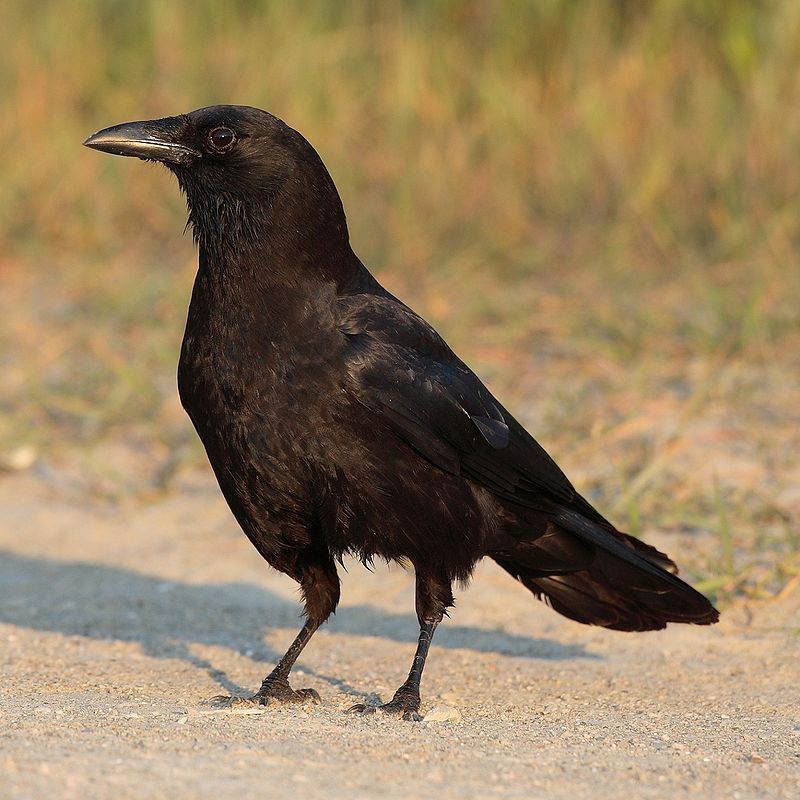
The American Crow is a large, intelligent, all-black bird with a distinctive cawing call. It’s found throughout North America in various habitats, including forests, fields, and urban areas.
American Crows are highly adaptable and opportunistic feeders, eating a wide range of food, including insects, fruits, small animals, and carrion. They are known for their problem-solving skills and complex social structures.
These birds often gather in large numbers, especially in winter roosts, and are known for mobbing predators like hawks and owls.
American Crows are monogamous and may stay with their mates for life. They are also known for using tools and having the ability to recognize individual human faces.
| Kingdom | Animalia |
| Phylum | Chordata |
| Clade | Dinosauria |
| Class | Aves |
| Order | Passeriformes |
| Family | Corvidae |
| Genus | Corvus |
| Species | C. brachyrhynchos |
35. Mountain Chickadee (Poecile gambeli)
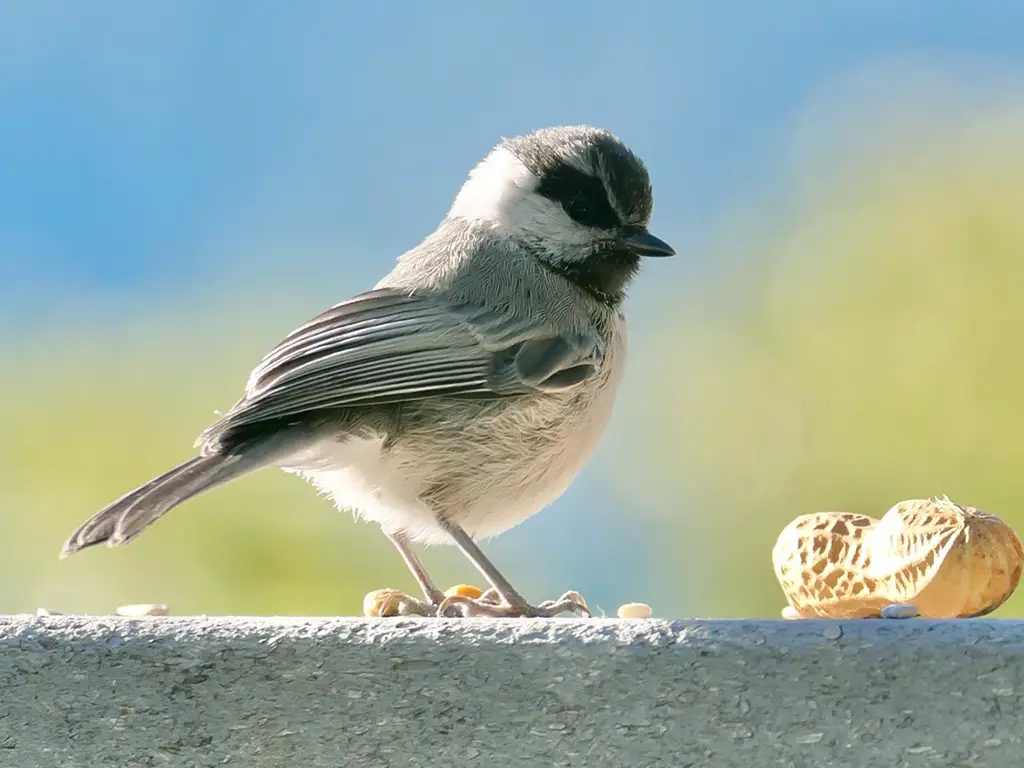
The Mountain Chickadee is a small, active bird with a distinctive white stripe above its eye, a black cap, and bib, and gray back and wings. It’s native to the mountainous regions of western North America.
Known for its curiosity and boldness, this bird is a frequent visitor to bird feeders. Its diet consists of insects, seeds, and berries.
The Mountain Chickadee’s distinctive call includes a high-pitched “chick-a-dee-dee-dee” and a two-toned whistle. They are cavity nesters, often using abandoned woodpecker holes.
These birds are well-adapted to cold climates and often join mixed-species flocks in winter.
| Kingdom | Animalia |
| Phylum | Chordata |
| Clade | Dinosauria |
| Class | Aves |
| Order | Passeriformes |
| Family | Paridae |
| Genus | Poecile |
| Species | P. gambeli |
36. White-Breasted Nuthatch (Sitta carolinensis)
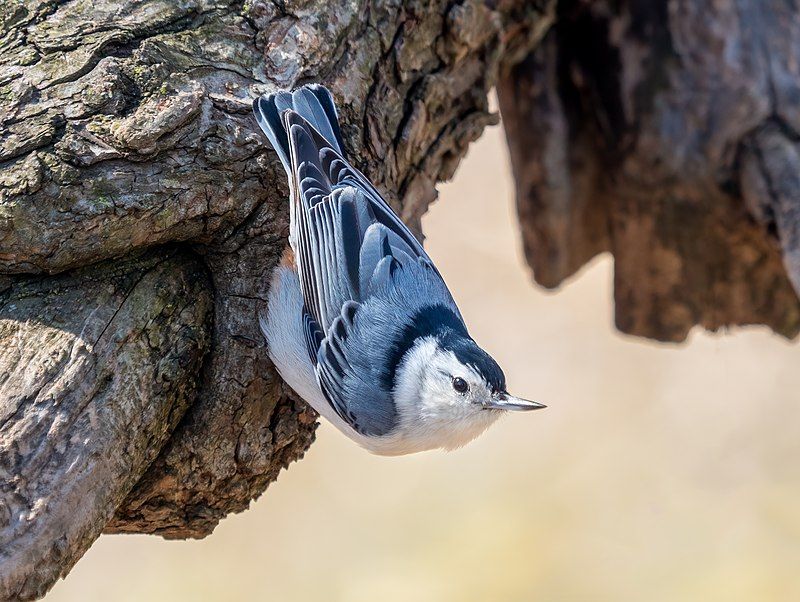
The White-Breasted Nuthatch is a small bird with a large head, short tail, and a strong bill. It has a white face and underparts, blue-gray upperparts, and a black cap.
Found across much of North America, it inhabits deciduous and mixed forests. It’s known for its habit of creeping down tree trunks headfirst and caching seeds under tree bark.
The White-Breasted Nuthatch feeds on insects, seeds, and nuts. Its call is a loud, nasal “yank-yank.” They are cavity nesters, often using old woodpecker holes.
Their ability to walk head-down on trees makes them a unique sight in their habitats.
| Kingdom | Animalia |
| Phylum | Chordata |
| Clade | Dinosauria |
| Class | Aves |
| Order | Passeriformes |
| Family | Sittidae |
| Genus | Sitta |
| Species | S. carolinensis |
37. Rusty Blackbird (Euphagus carolinus)
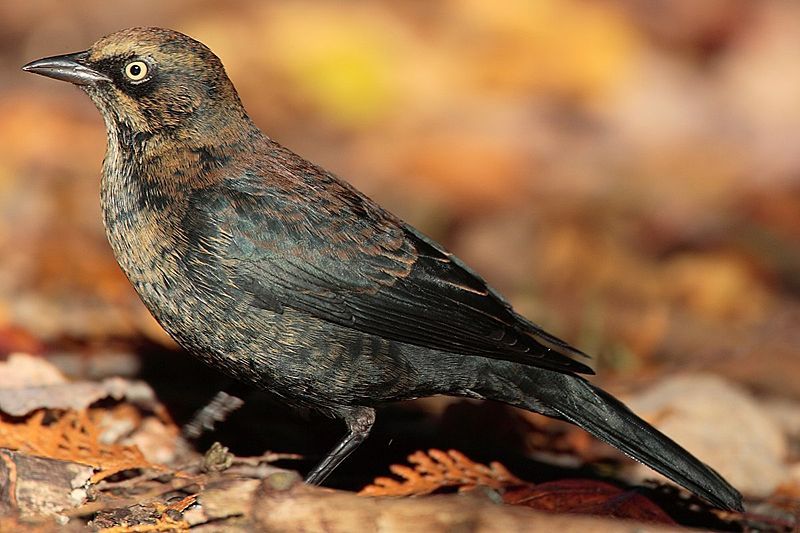
The Rusty Blackbird is a medium-sized blackbird with a rusty tinge to its feathers during the non-breeding season. Breeding males are glossy black.
It’s one of North America’s most rapidly declining songbirds, found in boreal forests and wetlands.
They feed on insects, seeds, and small invertebrates, often flipping leaves and debris to find food. Their song is a series of melodious whistles and gurgles, and they have a sharp, metallic call.
Rusty Blackbirds are elusive and less gregarious than other blackbird species. Conservation efforts are crucial for this species, as their population has experienced significant declines.
| Kingdom | Animalia |
| Phylum | Chordata |
| Clade | Dinosauria |
| Class | Aves |
| Order | Passeriformes |
| Family | Icteridae |
| Genus | Euphagus |
| Species | E. carolinus |
38. Lesser Goldfinch (Spinus psaltria)
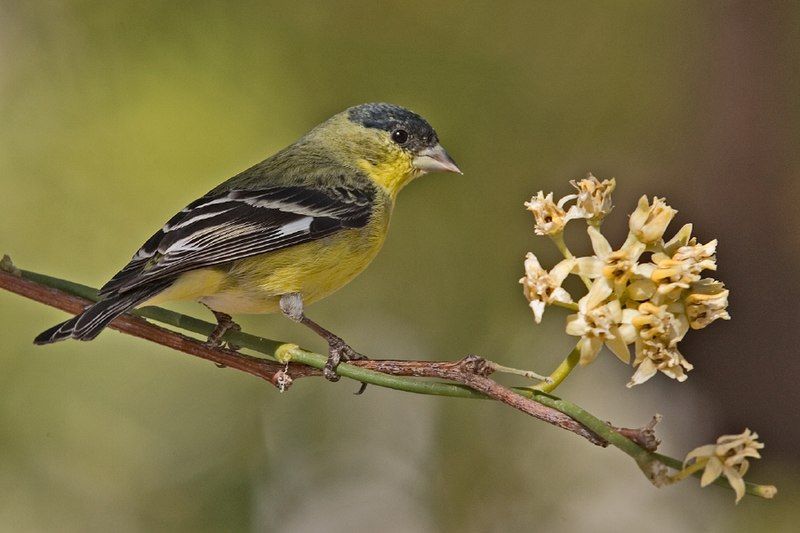
| Kingdom | Animalia |
| Phylum | Chordata |
| Clade | Dinosauria |
| Class | Aves |
| Order | Passeriformes |
| Family | Fringillidae |
| Genus | Spinus |
| Species | S. psaltria |
39. Ruby-Crowned Kinglet (Regulus calendula)
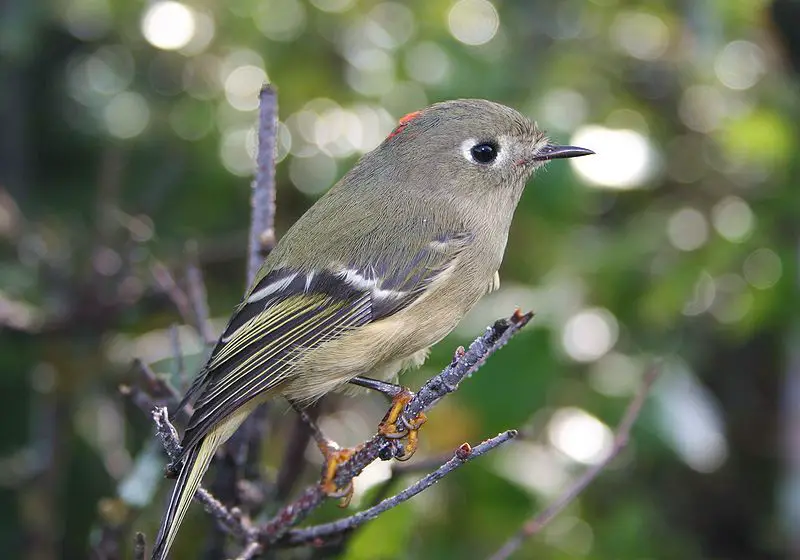
The Ruby-Crowned Kinglet is a tiny, energetic bird with olive-green plumage and a prominent white eye-ring. Its most distinctive feature, a ruby-red crown patch, is often hidden unless the bird is excited or agitated.
These kinglets are widespread across North America, inhabiting coniferous and mixed forests. They feed primarily on insects and spiders, often seen flitting about in trees and shrubs, constantly moving as they forage.
Ruby-crowned kinglets have a high-pitched, complex song despite their small size. They are migratory, breeding in northern forests and wintering in warmer southern regions.
During breeding, males display their red crown in courtship. These kinglets build well-concealed, cup-shaped nests in trees.
| Kingdom | Animalia |
| Phylum | Chordata |
| Clade | Dinosauria |
| Class | Aves |
| Order | Passeriformes |
| Family | Regulidae |
| Genus | Corthylio |
| Species | C. calendula |
40. Great Horned Owl (Bubo virginianus)
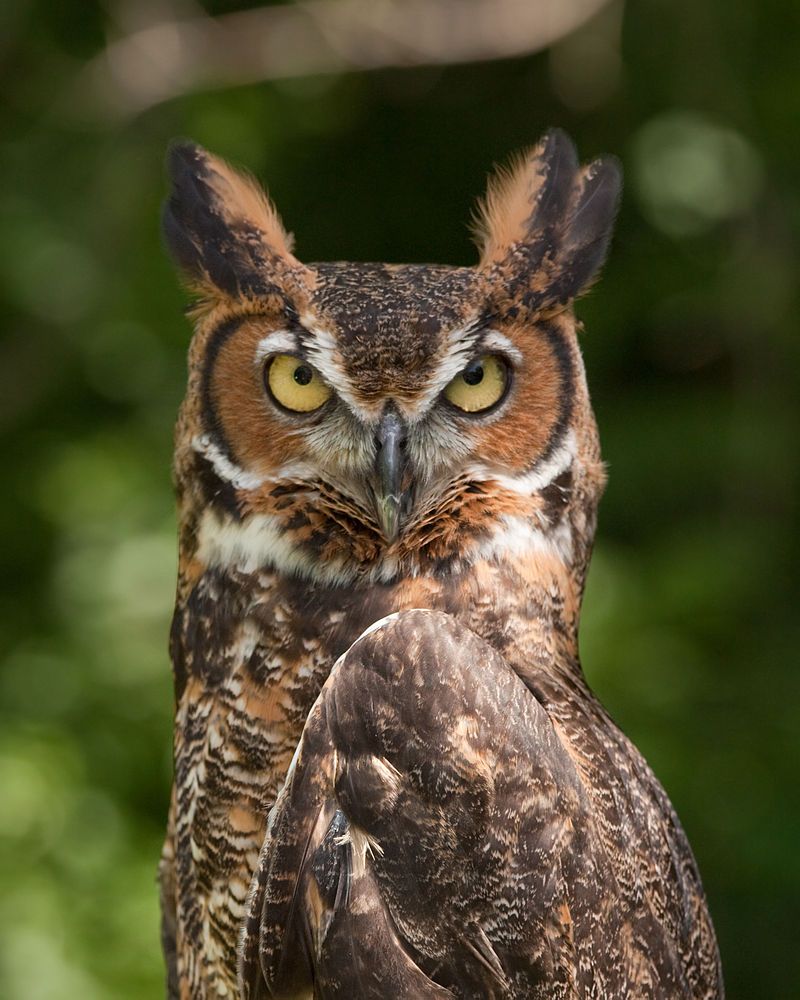
The Great Horned Owl is a large, powerful raptor known for its distinctive horn-like feather tufts on the head. It has a mottled gray-brown body, a reddish-brown face, and deep yellow eyes.
Widely distributed in the Americas, it inhabits forests, deserts, and urban areas. Great Horned Owls are versatile predators, feeding on a wide range of prey, including mammals, birds, and reptiles.
Their deep, resonating hoots are a common nighttime sound in their habitats. These owls are notable for their early breeding season, often nesting in winter. They don’t build their nests but use abandoned nests of other large birds.
| Kingdom | Animalia |
| Phylum | Chordata |
| Clade | Dinosauria |
| Class | Aves |
| Order | Strigiformes |
| Family | Strigidae |
| Genus | Bubo |
| Species | B. virginianus |
41. Anna’s Hummingbird (Calypte anna)
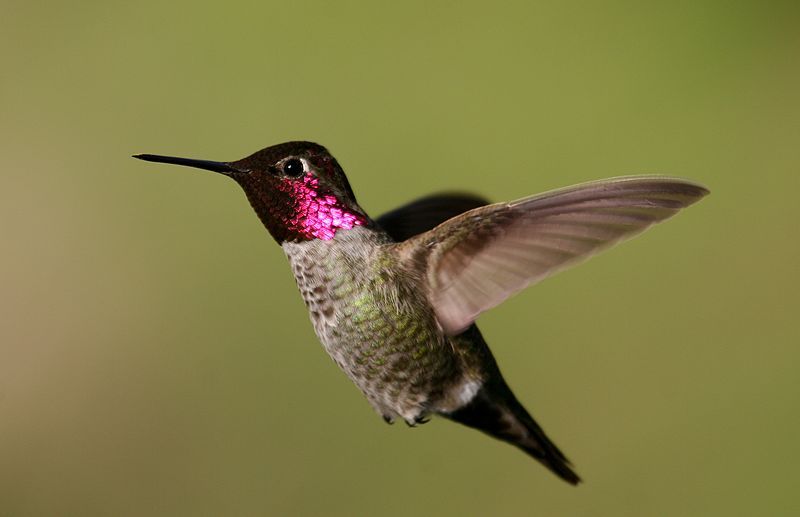
Anna’s Hummingbird is a small, vibrant bird known for its iridescent emerald feathers and a brilliant rose-pink throat in males. Females are more subdued with green upperparts and grayish underparts.
They are native to the western coastal regions of North America. Anna’s Hummingbirds are known for their remarkable flight abilities, including hovering and backward flight.
They feed primarily on nectar from flowers and feeders, supplemented with insects and spiders. These hummingbirds are territorial and often aggressive at feeding sites.
They have a distinctive sharp “chip” vocalization. Unlike most hummingbirds, Anna’s Hummingbirds are year-round residents in their range, not migrating like other species.
| Kingdom | Animalia |
| Phylum | Chordata |
| Clade | Strisores |
| Class | Aves |
| Order | Apodiformes |
| Family | Trochilidae |
| Genus | Calypte |
| Species | C. anna |
42. Eurasian Teal (Anas crecca)
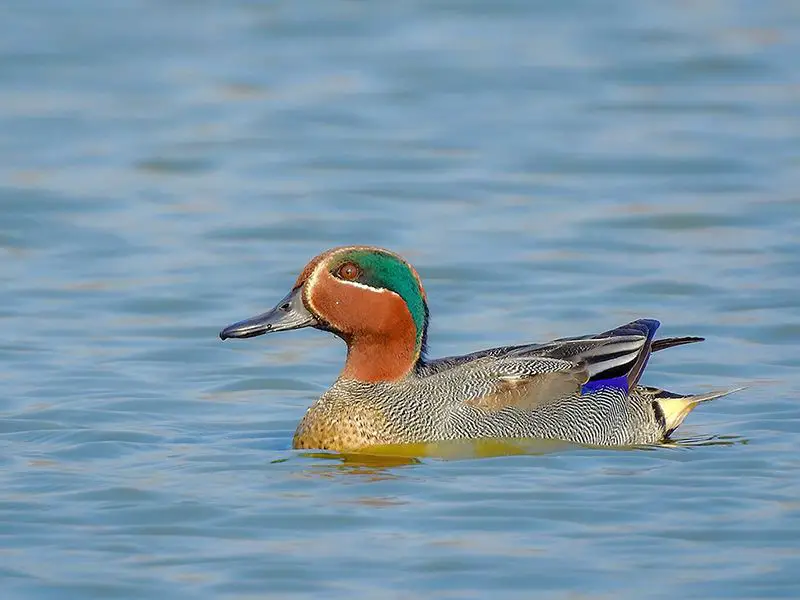
The Eurasian Teal is a small dabbling duck with a striking appearance. Males have chestnut-colored heads with broad green eye patches, while females are mottled brown for camouflage.
They are found across Europe and Asia and are known to migrate to warmer regions in winter. Eurasian Teals inhabit wetlands, marshes, and shallow lakes, feeding on aquatic invertebrates, plants, and seeds.
They are agile fliers and can take off quickly from the water. These ducks are social, and often found in large flocks during migration and wintering. Their call is a soft “krick” sound for males and a loud quack for females.
| Kingdom | Animalia |
| Phylum | Chordata |
| Clade | Dinosauria |
| Class | Aves |
| Order | Anseriformes |
| Family | Anatidae |
| Genus | Anas |
| Species | A. crecca |
43. Northern Pintail (Anas acuta)
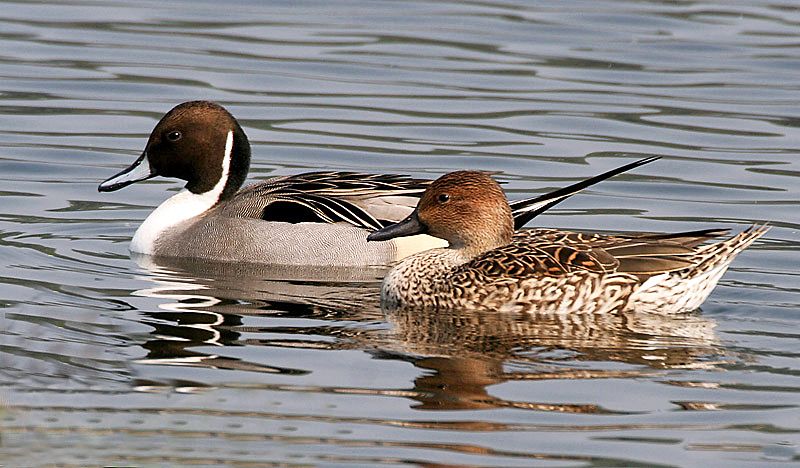
| Kingdom | Animalia |
| Phylum | Chordata |
| Clade | Dinosauria |
| Class | Aves |
| Order | Anseriformes |
| Family | Anatidae |
| Genus | Anas |
| Species | A. acuta |
44. Purple Finch (Haemorhous purpureus)
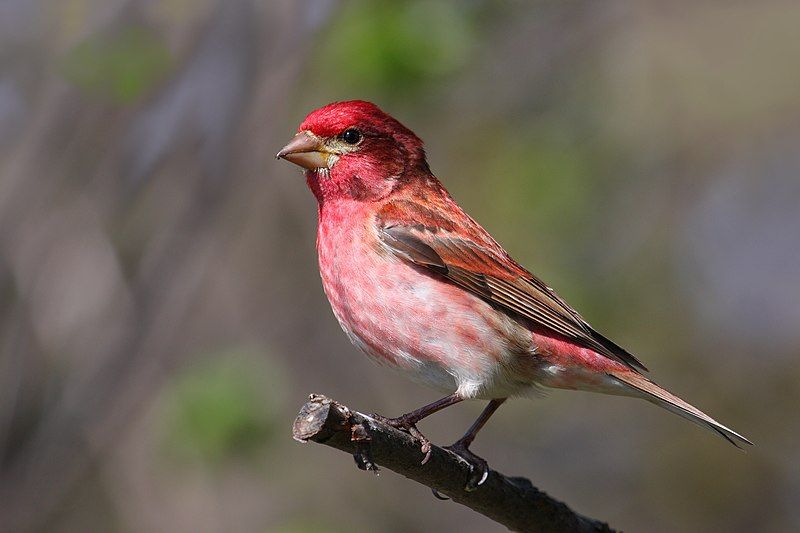
The Purple Finch is a small, brightly colored bird. Males have a striking raspberry-red plumage that covers their head, throat, and breast, blending into a brown back and tail.
Females are more subdued, with a brown and white-streaked appearance. Native to North America, they inhabit coniferous and mixed forests, as well as suburban areas and parks. Purple Finches primarily eat seeds, berries, and insects.
They are known for their melodious warbling song and can be seen at bird feeders, especially in the winter. Their populations have been declining due to competition with the introduced House Sparrow and habitat loss.
| Kingdom | Animalia |
| Phylum | Chordata |
| Clade | Dinosauria |
| Class | Aves |
| Order | Passeriformes |
| Family | Fringillidae |
| Genus | Haemorhous |
| Species | H. purpureus |
45. California Quail (Callipepla californica)
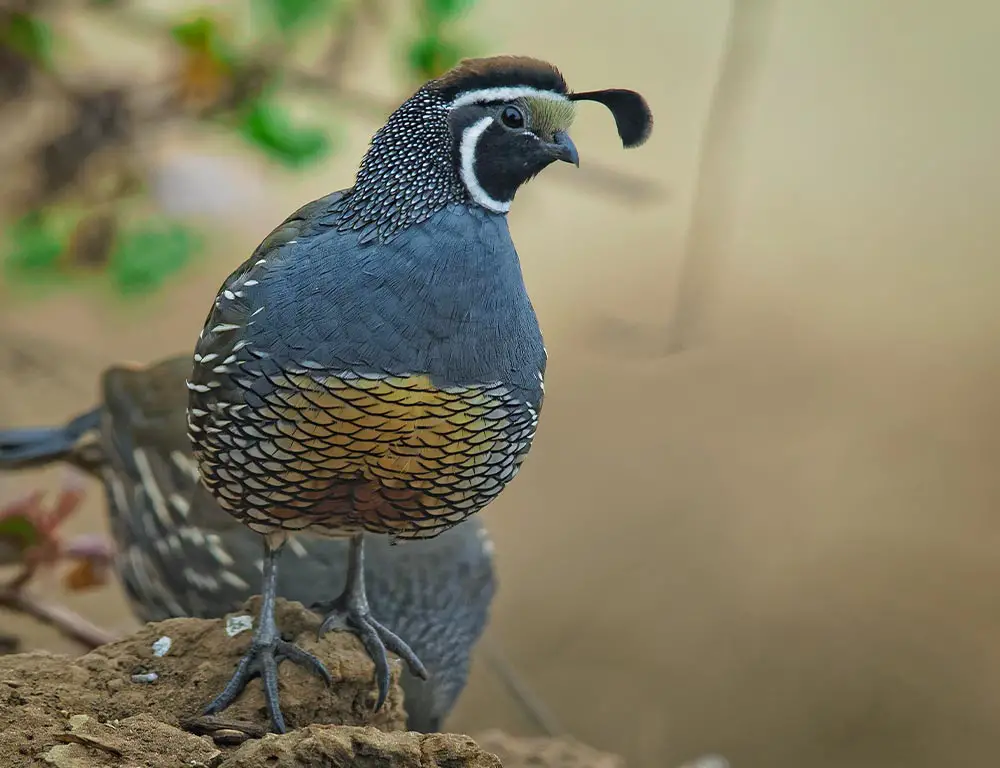
The California Quail is a plump, ground-dwelling bird, recognizable by its curved black topknot. Males have gray and brown bodies with black faces outlined in white, while females are more mottled brown for camouflage.
They are native to the western United States, particularly California, living in scrub, grasslands, and open woodlands. California Quails feed on seeds, leaves, and insects. They are social birds, often seen in small groups called coveys.
Their call, a distinctive “Chi-ca-go,” is a common sound in their habitat. These quails are vital for seed dispersal in their ecosystems.
| Kingdom | Animalia |
| Phylum | Chordata |
| Clade | Dinosauria |
| Class | Aves |
| Order | Galliformes |
| Family | Odontophoridae |
| Genus | Callipepla |
| Species | C. californica |
46. Eurasian Goshawk (Accipiter gentilis)
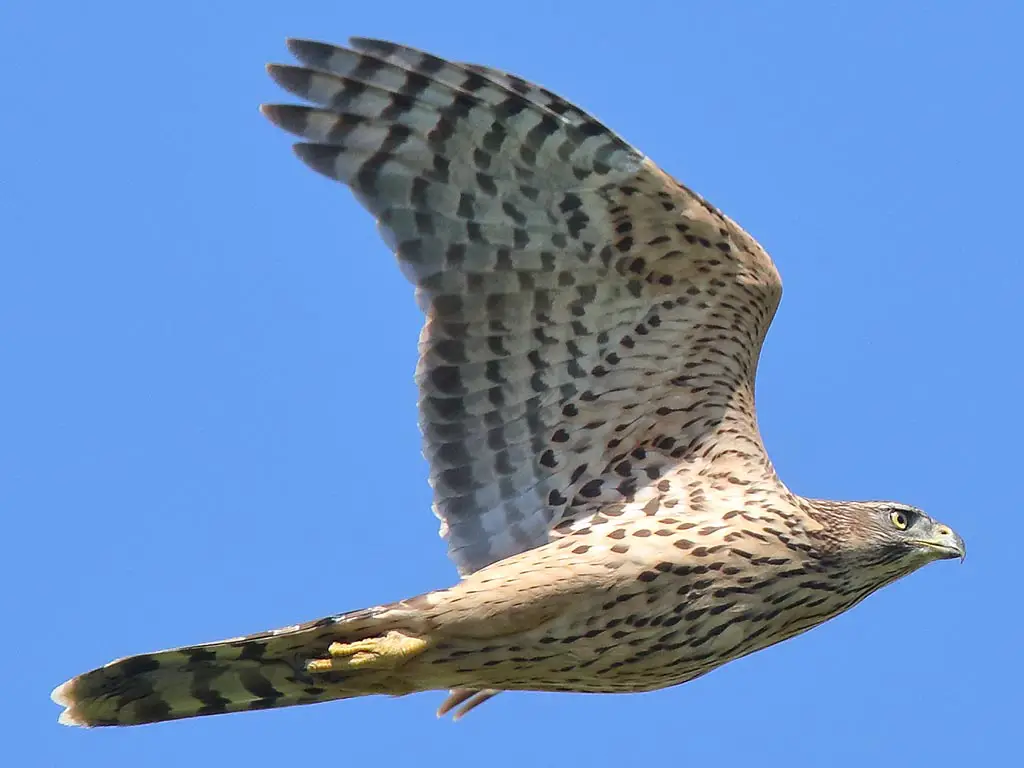
The Eurasian Goshawk is a large, powerful bird of prey, with a broad wingspan and a long tail. Adults have slate-gray plumage, a white eyebrow stripe, and a barred tail.
Found across Europe and Asia, they inhabit forests and woodlands. Goshawks are stealthy hunters, preying on birds and small mammals, often captured after a fast, agile chase through the trees.
They are solitary and territorial, known for their fierce defense of their nesting sites. Goshawks play a crucial role in controlling the populations of their prey species.
| Kingdom | Animalia |
| Phylum | Chordata |
| Clade | Dinosauria |
| Class | Aves |
| Order | Accipitriformes |
| Family | Accipitridae |
| Genus | Accipiter |
| Species | A. gentilis |
47. Steller’s Jay (Cyanocitta stelleri)
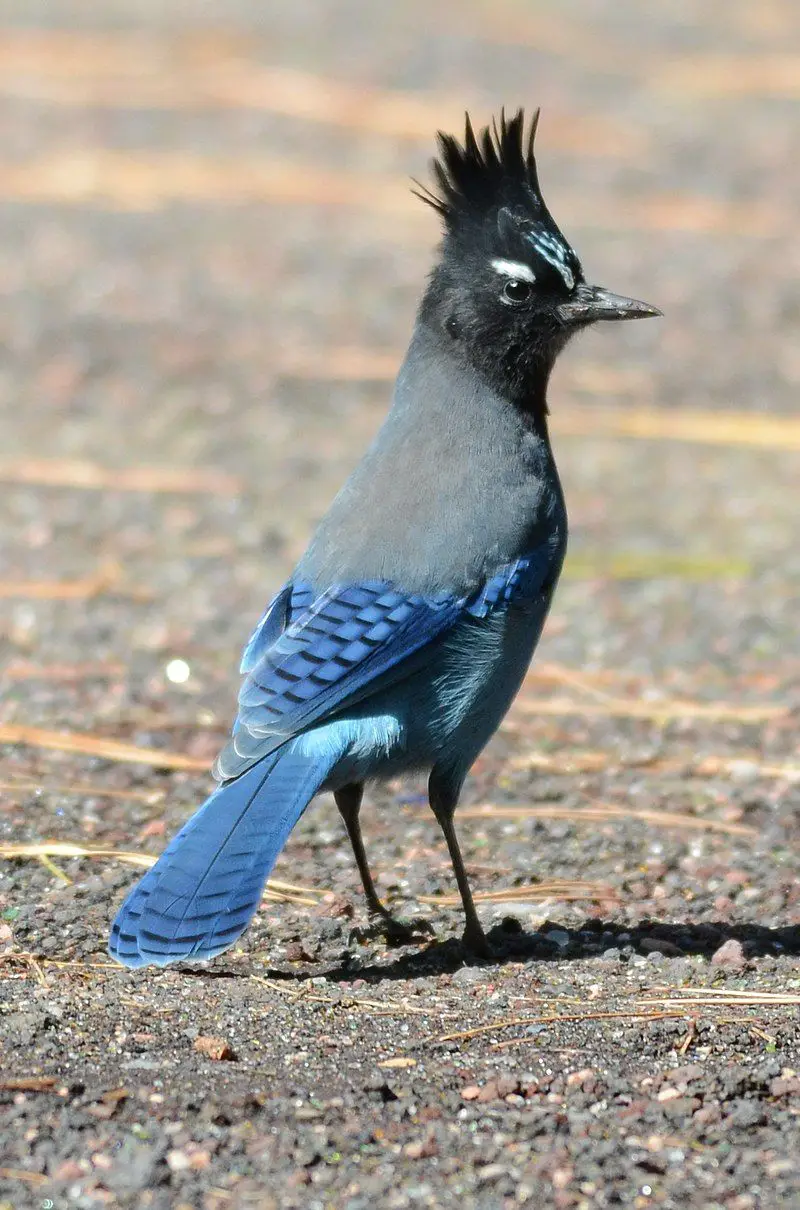
Steller’s Jay is a striking, crested jay with a black head and upper body, and a bright blue lower body. Native to western North America, they inhabit coniferous forests, often seen near campgrounds and picnic areas.
These jays are known for their intelligence, mimicking other birds, and even mechanical sounds. They are omnivorous, feeding on nuts, seeds, insects, and occasionally small animals.
Steller’s Jays are bold and inquisitive, often interacting with humans. They play an important role in seed dispersal and forest regeneration.
| Kingdom | Animalia |
| Phylum | Chordata |
| Clade | Dinosauria |
| Class | Aves |
| Order | Passeriformes |
| Family | Corvidae |
| Genus | Cyanocitta |
| Species | C. stelleri |
48. Winter Wren (Troglodytes hiemalis)
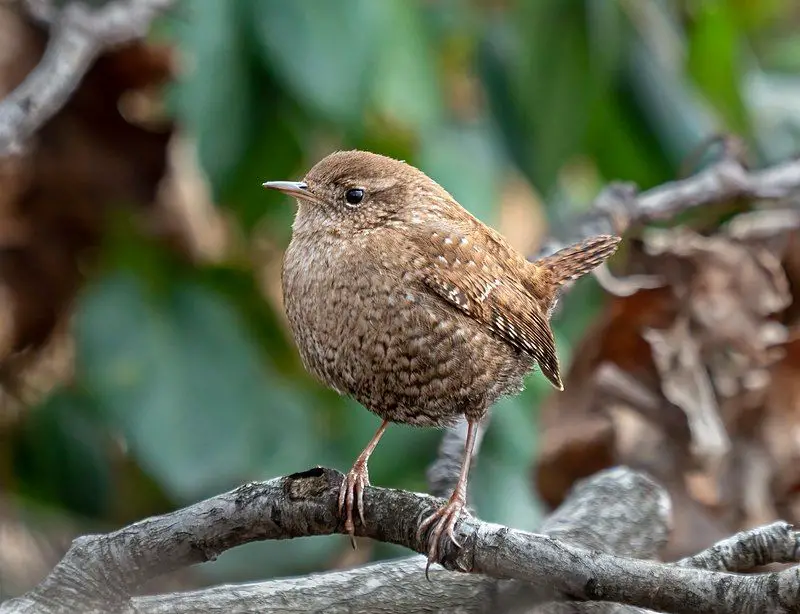
The Winter Wren is a tiny bird with a short tail, often held upright. It has rich brown plumage with fine dark barring. Found in dense undergrowth of forests in North America, it is known for its powerful and melodious song.
Winter Wrens feed on insects and spiders, often foraging in leaf litter. They build dome-shaped nests in crevices or under roots.
Despite their small size, Winter Wrens are hardy, with some populations residing year-round in northern areas, while others migrate to warmer climates.
| Kingdom | Animalia |
| Phylum | Chordata |
| Clade | Dinosauria |
| Class | Aves |
| Order | Passeriformes |
| Family | Troglodytidae |
| Genus | Troglodytes |
| Species | T. hiemalis |
49. Barn Swallow (Hirundo rustica)
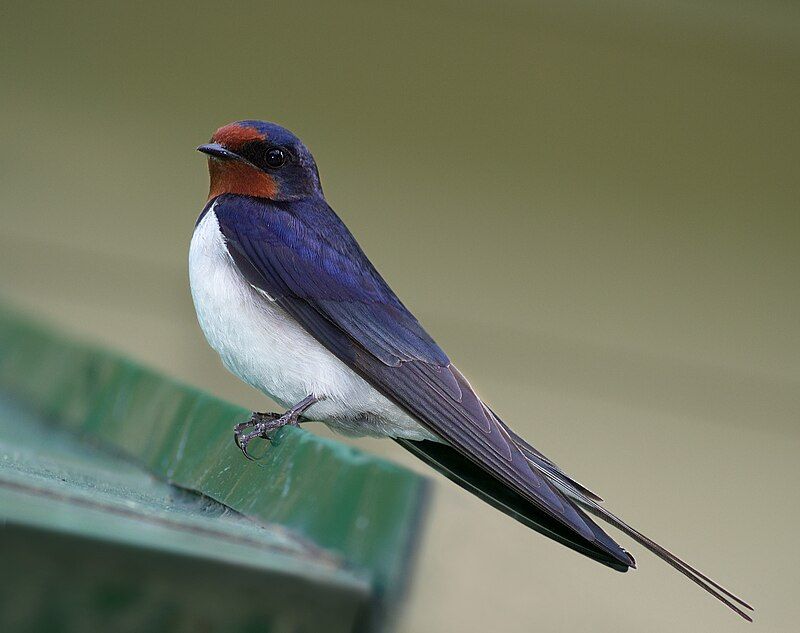
| Kingdom | Animalia |
| Phylum | Chordata |
| Clade | Dinosauria |
| Class | Aves |
| Order | Passeriformes |
| Family | Hirundinidae |
| Genus | Hirundo |
| Species | H. rustica |
50. Evening Grosbeak (Coccothraustes vespertinus)
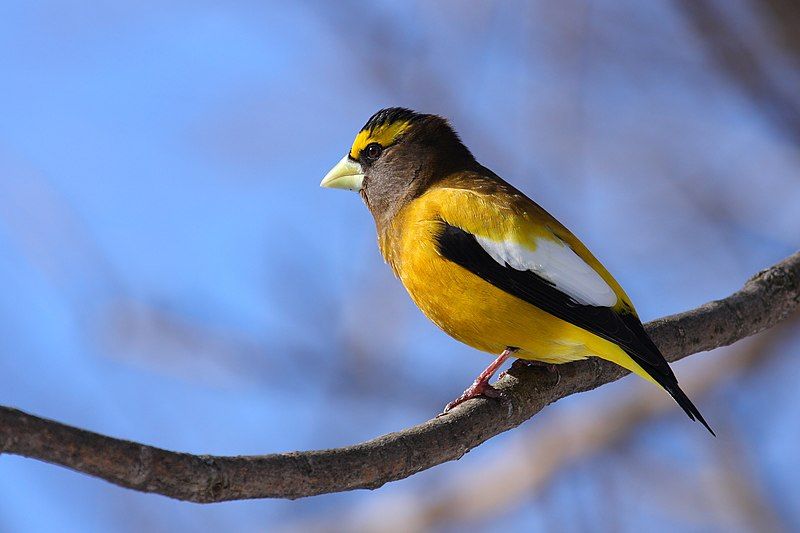
The Evening Grosbeak is a large, stocky finch with a striking appearance. Males have a bright yellow body, black wings with white patches, and a large pale bill; females are gray with hints of yellow and white.
Native to North America, they inhabit mixed forests and are often seen at bird feeders. Evening Grosbeaks feed on seeds, berries, and insects.
They have a loud, ringing call and are known for their irregular migration patterns. These birds were once very common, but their populations have declined, possibly due to habitat changes and reductions in food availability.
| Kingdom | Animalia |
| Phylum | Chordata |
| Clade | Dinosauria |
| Class | Aves |
| Order | Passeriformes |
| Family | Fringillidae |
| Genus | Hesperiphona |
| Species | H. vespertina |
51. Brown-Headed Cowbird (Molothrus ater)
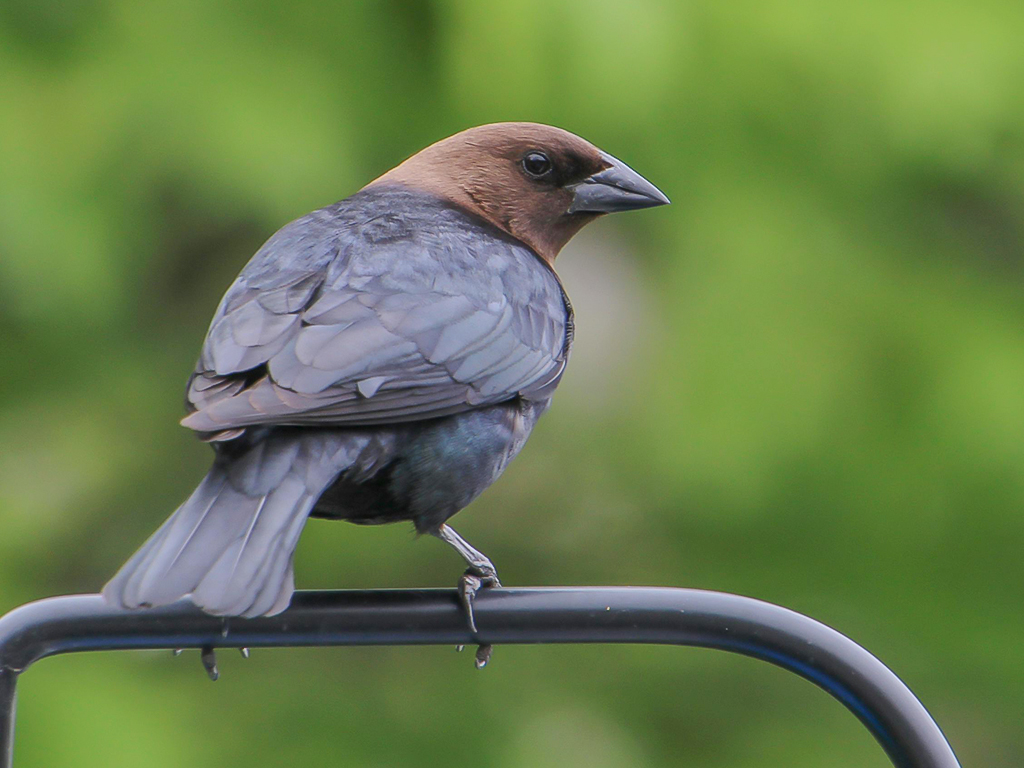
| Kingdom | Animalia |
| Phylum | Chordata |
| Clade | Dinosauria |
| Class | Aves |
| Order | Passeriformes |
| Family | Icteridae |
| Genus | Molothrus |
| Species | M. ater |
Conclusion
Winter birds in Idaho play a significant role in the state’s ecosystem and are a delight to observe for both birdwatchers and nature enthusiasts.
The wintering populations of waterfowl, raptors, and various songbirds contribute to the diversity and balance of Idaho’s wildlife. Their ability to adapt to the harsh winter conditions and find food sources showcases their resilience and survival skills.
Protecting the habitats and providing sufficient resources for these winter birds is crucial for their continued presence and for maintaining the ecological balance in Idaho.
By appreciating and understanding the importance of winter birds, we can contribute to their conservation and ensure their presence in the years to come.